Bermuda
Bermuda (/bərˈmjuːdə/; in full, The Somers Isles, or Islands of Bermuda) is a British Overseas Territory in the North Atlantic Ocean. It is approximately 1,035 km (643 mi) east-southeast of Cape Hatteras, North Carolina (with Cape Point on Hatteras Island being the nearest landfall); 1,236 km (768 mi) south of Cape Sable Island, Nova Scotia; 1,759 km (1,093 mi) northeast of Cuba, and 1,538 km (956 mi) due north of the British Virgin Islands. Though it is typically referred to in the singular, Bermuda consists of 181 islands; the largest of these islands is known as Main Island. The capital city of Bermuda is Hamilton. Bermuda is internally self-governing, with its own constitution and cabinet of ministers selected from the elected Members of the lower house of a Parliament that enacts local laws. As the national government, the Government of the United Kingdom is ultimately responsible for ensuring good governance within British Overseas Territories, and retains responsibility for defence and foreign relations. As of July 2018, it has a population of 71,176, making it the most populous of the British overseas territories.[1] Bermuda's largest industries are offshore insurance, reinsurance, and tourism.[5][6] Bermuda had one of the world's highest GDP per capita for most of the 20th century.[7]
Bermuda | |
|---|---|
| Motto: | |
| Anthem: "God Save the Queen" | |
| Unofficial territorial song: "Hail to Bermuda" | |
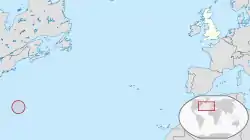 _(Americas_centered).svg.png.webp) | |
| Sovereign state | United Kingdom |
| English settlement | 1612 |
| Capital | Hamilton 32°18′N 64°47′W |
| Largest city | St. George's |
| Official languages | English |
| Ethnic groups (2016[2]) |
|
| Demonym(s) | Bermudian |
| Government | Parliamentary dependency under a constitutional monarchy |
• Monarch | Elizabeth II |
• Governor | Rena Lalgie |
• Premier | E. David Burt |
| Legislature | Parliament |
| Senate | |
| House of Assembly | |
| Government of the United Kingdom | |
| Rt Hon Boris Johnson MP | |
• Minister | To be Confirmed (As of 25 November 2020) |
| Area | |
• Total | 53.2 km2 (20.5 sq mi) |
• Water (%) | 27 |
| Highest elevation | 259 ft (79 m) |
| Population | |
• 2018 estimate | 71,176[1] (205th) |
• 2016 census | 63,779 |
• Density | 1,338/km2 (3,465.4/sq mi) (9th) |
| GDP (nominal) | 2019[3] estimate |
• Total | $6.269 billion (161st (estimate)) |
• Per capita | $102,192 (4th) |
| Currency | Bermudian dollar (BMD) |
| Time zone | UTC−04:00 (AST[4]) |
| UTC−03:00 (ADT) | |
| Date format | dd/mm/yyyy |
| Driving side | left |
| Calling code | +1-441 |
| ISO 3166 code | BM |
| Internet TLD | .bm |
Bermuda's climate is usually described as subtropical,[8] primarily due to the chilly but generally mild winter temperatures. Unlike other areas designated as subtropical, summers are also quite mild, with temperatures not rising in most years above 30 °C (86 °F) during the hottest months of July and August. Its climate also exhibits oceanic features similar to other oceanic islands and the western coasts of continents in the Northern Hemisphere: mean wind direction is from the west and carries warm, moist air from the ocean, ensuring relatively high humidity and stabilising temperature. Bermuda lies in Hurricane Alley and is thus prone to severe weather; however, it receives some protection from a coral reef and its position at the north of the belt, which limits the direction and severity of approaching storms.[9]
Etymology
Bermuda is named after the Spanish sailor Juan de Bermúdez, who discovered the islands in 1505.[1]
An early appearance of the name in English literature is in Shakespeare's The Tempest, a play which was inspired by the wreck of the Sea Venture, though not set on the islands:
Thou call'dst me up at midnight to fetch dew
From the still-vex'd Bermoothes[10]
John Donne's poem The Storm uses the same idea:
Compar'd to these stormes, death is but a qualme,
Hell somewhat lightsome, and the’Bermuda calme.
History
Discovery
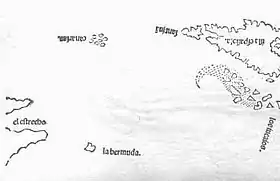
Bermuda was discovered in the early 1500s by Spanish explorer Juan de Bermúdez.[11][12] Bermuda had no indigenous population at the time of its discovery, nor at the time of the initial British settlement a century later.[13] It was mentioned in Legatio Babylonica, published in 1511 by historian Pedro Mártir de Anglería, and was also included on Spanish charts of that year.[14] Both Spanish and Portuguese ships used the islands as a replenishment spot to take on fresh meat and water; for example, shipwrecked Portuguese mariners are now thought to have been responsible for the 1543 inscription on Portuguese Rock (previously called Spanish Rock).[15] Legends arose of spirits and devils, now thought to have stemmed from the calls of raucous birds (most likely the Bermuda petrel, or cahow)[16] and the loud noise heard at night from wild hogs.[17] Combined with the frequent storm-wracked conditions and the dangerous reefs, the archipelago became known as the 'Isle of Devils'.[18] Neither Spain nor Portugal attempted to settle it.
Settlement by the English
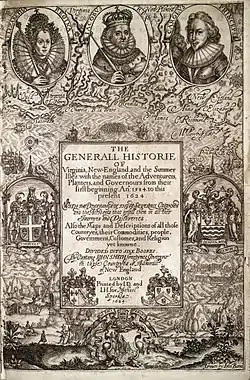
For the next century, the island is believed to have been visited frequently, but not settled. The English had by this time started to take an interest in the New World, initially attempting to settle in Virginia in what is now the eastern United States. After the failure of the first two English colonies there, a more determined effort was initiated by King James I of England, who granted a Royal Charter to the Virginia Company which established a colony at Jamestown, Virginia in 1607. Two years later, a flotilla of seven ships left England under the company's admiral, Sir George Somers, and the new governor of Jamestown, Sir Thomas Gates, with several hundred settlers, food and supplies to relieve the colony of Jamestown.[19] However the flotilla was broken up by a storm; as the flagship, Sea Venture, was taking on water, Somers drove it onto Bermuda's reef and reached the shores safely with smaller boats – all 150 passengers and a dog survived.[11] (William Shakespeare's play The Tempest, in which the character Ariel refers to the "still-vex'd Bermoothes" (I.ii.229), is thought to have been inspired by William Strachey's account of this shipwreck.)[11][20][21] They stayed 10 months, starting a new settlement and building two small ships, the Deliverance and the Patience, to sail on to Jamestown. Bermuda was claimed for the English Crown, and the charter of the Virginia Company was later extended to include it.
On 10 May 1610, all but two of the remaining survivors of Sea Venture sailed on to Jamestown (excluding those who had died or been killed on Bermuda, or the crew of the Sea Venture's longboat, sent under Henry Ravens to Virginia a month after the wreck of the Sea Venture, none of whom were seen again; but including children born in Bermuda). Among them was John Rolfe, whose wife and child died and were buried in Bermuda. Somers returned to Bermuda with the Patience to obtain food for the starving settlers of Jamestown but died in Bermuda; the Patience sailed instead for England, leaving a third man with the two who had remained behind in May. In 1612, the English began the intentional settlement of the archipelago, officially named Virgineola,[22] with the arrival of the ship the Plough. New London (soon renamed St. George's Town) was settled that year and designated as the colony's first capital.[23][14] It is the oldest continually inhabited English town in the New World.[5]
In 1615, the colony, which had been renamed the Somers Isles in commemoration of Sir George Somers, was passed on to a new company, the Somers Isles Company.[24][25] As Bermudians settled the Carolina Colony and contributed to the establishment of other English colonies in the Americas, several other locations were named after the archipelago. During this period the first enslaved people were held against their will and trafficked to the islands. These were a mixture of enslaved native Africans who were trafficked to the Americas via the African slave trade and Native Americans who were enslaved from the Thirteen Colonies.[11]
The archipelago's limited land area and resources led to the creation of what may be the earliest conservation laws of the New World. In 1616 and 1620 acts were passed banning the hunting of certain birds and young tortoises.[26]
Civil War

In 1649, the English Civil War was in its seventh year and King Charles I was beheaded in Whitehall, London. The conflict spilled over into Bermuda, where the majority of the colonists developed a strong sense of devotion to the Crown. The royalists ousted the Somers Isles Company's Governor, Captain Thomas Turner, and elected John Trimingham as their leader. Bermuda's civil war was ended by militias, and dissenters such as Puritans and Independents were pushed to settle The Bahamas under William Sayle.[27]
The rebellious royalist colonies of Bermuda and Virginia, as well as Barbados and Antigua, were the subjects of an Act of the Rump Parliament of England that was essentially a declaration of war:
[W]hereas divers acts of Rebellion have been committed by many persons inhabiting in Barbada's, Antego, Bermuda's and Virginia, whereby they have most Trayterously, by Force and Subtilty, usurped a Power of Government, and seized the Estates of many well-affected persons into their hands, and banished others, and have set up themselves in opposition to, and distinct from this State and Commonwealth, . . . the Parliament of England taking the premises into consideration, and finding themselves obliged to use all speedy, lawful and just means for the Suppression of the said Rebellion in the said Plantations, and reducing the same to fidelity and due obedience, so as all peaceable and well-affected people, who have been Robbed, Spoiled, Imprisoned or Banished through the said Treasonable practices, may be restored to the freedom of their persons, and possession of their own Lands and Goods, and due punishment inflicted upon the said Delinquents, do Declare all and every the said persons in Barbada's, Antego, Bermuda's and Virginia, that have contrived, abetted, aided or assisted those horrid Rebellions, or have since willingly joyned with them, to be notorious Robbers and Traitors, and such as by the Law of Nations are not to be permitted any maner of Commerce or Traffique with any people whatsoever; and do forbid to all maner of persons, Foreiners, and others, all maner of Commerce, Traffique and Correspondency whatsoever, to be used or held with the said Rebels in the Barbada's, Bermuda's, Virginia and Antego, or either of them.[28]
The royalist colonies were also threatened with invasion. The Government of Bermuda eventually reached an agreement with the Parliamentarians in England which left the status quo in Bermuda.
Later 17th century
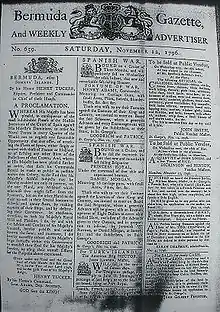
In the 17th century, the Somers Isles Company suppressed shipbuilding, as it needed Bermudians to farm in order for it to generate income from the land. The colony of Virginia far surpassed Bermuda in both quality and quantity of tobacco produced. Bermudians began to turn to maritime trades relatively early in the 17th century, but the Somers Isles Company used all its authority to suppress turning away from agriculture. This interference led to the islanders demanding, and receiving, the revocation of the company's charter in 1684, and the company was dissolved.[11]
Bermudians rapidly abandoned agriculture for shipbuilding, replanting farmland with the native juniper (Juniperus bermudiana, called Bermuda cedar) trees that grew thickly over the entire island. Establishing effective control over the Turks Islands, Bermudians deforested their landscape to begin the salt trade. It became the world's largest and remained the cornerstone of Bermuda's economy for the next century. Bermudians also vigorously pursued whaling, privateering, and the merchant trade.
The Bermuda sloop became highly regarded for its speed and manoeuvrability, and was soon adapted for service with the Royal Navy. The Bermuda sloop HMS Pickle carried dispatches of the victory at Trafalgar, and news of the death of Admiral Nelson, to England.[29]
Bermuda and the American War of Independence
Bermuda's ambivalence towards the American rebellion changed in September 1774, when the Continental Congress resolved to ban trade with Great Britain, Ireland, and the West Indies after 10 September 1775. Such an embargo would mean the collapse of their intercolonial commerce, famine and civil unrest. Lacking political channels with Great Britain, the Tucker Family met in May 1775 with eight other parishioners, and resolved to send delegates to the Continental Congress in July, with the goal of an exemption from the ban. Henry Tucker noted a clause in the ban which allowed the exchange of American goods for military supplies. The clause was confirmed by Benjamin Franklin when Tucker met with the Pennsylvania Committee of Safety. Independently, Tucker's sons St. George and Thomas Tudor confirmed this business arrangement with Peyton Randolph and the Charlestown Committee of Safety, while another Bermudian, Harris, did so with George Washington.[30]
Three American vessels, independently operating from Charlestown, Philadelphia and Newport, sailed to Bermuda, and on 14 August 1775, 100 barrels of gunpowder were taken from the Bermudian magazine, while Governor George James Bruere slept, and loaded onto these vessels. As a consequence, on 2 October the Continental Congress exempted Bermuda from their trade ban, and Bermuda acquired a reputation for disloyalty. Later that year, the British Parliament passed the Prohibitory Act to prohibit trade with the American rebelling colonies, and sent HMS Scorpion to keep watch over the island. The island's forts were stripped of cannon, such that by the end of 1775, all of Bermuda's forts were without cannon, shot and powder. Yet, wartime trade of contraband continued along well-established family connections. With 120 vessels by 1775, Bermuda continued to trade with St. Eustatius until 1781, and provided salt to North American ports, despite the presence of hundreds of privateers.[30]:389–415
In June 1776, HMS Nautilus secured the island, followed by HMS Galatea in September. Yet, the two British captains seemed more intent on capturing prize money, causing a severe food shortage on the island until the departure of Nautilus in October. After France's entry into the war in 1778, Sir Henry Clinton refortified and garrisoned the island under the command of Major William Sutherland. As a result, 91 French and American ships were captured in the winter of 1778–1779, bringing the population once again to the brink of starvation. Bermudian trade was severely hampered by the combined efforts of the Royal Navy, the British garrison and loyalist privateers, such that famine struck the island in 1779.[30]:416–427
The death of George Bruere in 1780 turned the governorship over to his son, George Jr., an active loyalist. Under his leadership, smuggling was stopped, and the Bermudian colonial government populated with like-minded loyalists. Even Henry Tucker abandoned trading with the United States, because of the presence of many privateers. Loyalist privateers based in Bermuda captured 114 prizes between 1777 and 1781, while 130 were captured in 1782.[30]:428–433
The Bermuda Gazette, Bermuda's first newspaper, began publishing in 1784.[31][32][33]
19th century
.png.webp)
After the American Revolution, the Royal Navy began improving the harbours on the Bermudas. In 1811, work began on the large Royal Naval Dockyard on Ireland Island, in the west of the chain, which was to serve as the islands' principal naval base guarding the western Atlantic Ocean shipping lanes. To guard the dockyard, the British Army built a large Bermuda Garrison, and heavily fortified the archipelago.
During the War of 1812 between Britain and the United States, the British attacks on Washington, D.C. and the Chesapeake were planned and launched from Bermuda, where the headquarters of the Royal Navy's North American Station had recently been moved from Halifax, Nova Scotia.
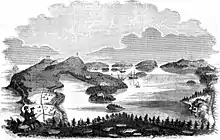
In 1816, James Arnold, the son of Benedict Arnold, fortified Bermuda's Royal Naval Dockyard against possible US attacks.[34] Today, the National Museum of Bermuda, which incorporates Bermuda's Maritime Museum, occupies the Keep of the Royal Naval Dockyard, including the Commissioner's House, and exhibits artefacts of the base's military history.
The British abolished the slave trade in 1807, but not the institution itself.[35] As a result of frequent slave rebellions in their other colonies, as well as the efforts of British abolitionists, the British Parliament abolished slavery in 1833.[14][11]
Due to its proximity to the southeastern US coast, Bermuda was frequently used during the American Civil War as a stopping point base for the Confederate States' blockade runners on their runs to and from the Southern states, and England, to evade Union naval vessels on blockade patrol;[14][11] the blockade runners were then able to transport essential war goods from England and deliver valuable cotton back to England. The old Globe Hotel in St George's, which was a centre of intrigue for Confederate agents, is preserved as a public museum.
Anglo-Boer War
During the Anglo-Boer War (1899–1902), 5,000 Boer prisoners of war were housed on five islands of Bermuda. They were located according to their views of the war. "Bitterenders" (Afrikaans: Bittereinders), who refused to pledge allegiance to the British Crown, were interned on Darrell's Island and closely guarded. Other islands such as Morgan's Island held 884 men, including 27 officers; Tucker's Island held 809 Boer prisoners, Burt's Island 607, and Port's Island held 35.[36]
The New York Times reported an attempted mutiny by Boer prisoners of war en route to Bermuda and that martial law was enacted on Darrell's Island,[37] in addition to the escape of three Boer prisoners to mainland Bermuda,[38] a young Boer soldier stowed away and sailed from Bermuda to New York on the steamship Trinidad.[39]
The most famous escapee was the Boer prisoner of war Captain Fritz Joubert Duquesne, who was serving a life sentence for "conspiracy against the British government and on (the charge of) espionage".[40] On the night of 25 June 1902, Duquesne slipped out of his tent, worked his way over a barbed-wire fence, swam 1.5 miles (2.4 km) past patrol boats and bright spotlights, through storm-wracked waters, using the distant Gibbs Hill Lighthouse for navigation until he arrived ashore on the main island.[41] From there he escaped to the port of St. George's and a week later, he stowed away on a boat heading to Baltimore, Maryland.[42] He settled in the US and later became a spy for Germany in both World Wars. He claimed to be responsible for the 1916 death of Lord Kitchener in the sinking of HMS Hampshire, the head of the British Army who had also commanded British forces in South Africa during the second Boer War, but this had resulted from a mine. In 1942, Col. Duquesne was arrested by the FBI for leading the Duquesne Spy Ring, which still to this day is the largest espionage case in the history of the United States.[43]
Lord Kitchener's brother, Lt. Gen. Sir Walter Kitchener, had been the governor of Bermuda from 1908 until his death in 1912. His son, Major Hal Kitchener, bought Hinson's Island (with his partner, Major Hemming, another First World War aviator). The island had formerly been part of the Boer POW camp, housing teenaged prisoners from 1901 to 1902.
20th and 21st centuries
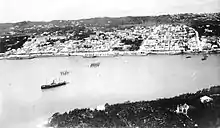

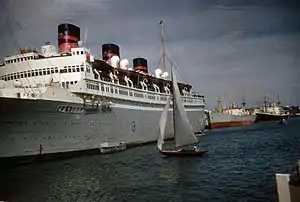
In the early 20th century, as modern transport and communication systems developed, Bermuda became a popular destination for American, Canadian and British tourists arriving by sea. The United States Smoot–Hawley Tariff Act of 1930, which enacted protectionist trade tariffs on goods imported into the US, led to the demise of Bermuda's once-thriving agricultural export trade to America and encouraged the development of tourism as an alternative source of income. The island was one of the centres for illegal alcohol smuggling during the era of Prohibition in the United States (1920–1933).[14][11]
In 1930, after several failed attempts, a Stinson Detroiter seaplane flew to Bermuda from New York City, the first aeroplane ever to reach the islands. The flight was not without incident, as the aircraft had to land twice in the ocean, once because of darkness and again when it needed to refuel. Navigation and weather forecasting improved in 1933 when the Royal Air Force (then responsible for providing equipment and personnel for the Royal Navy's Fleet Air Arm) established a station at the Royal Naval Dockyard to repair float planes (and supply replacements) for the fleet. In 1936, Luft Hansa began to experiment with seaplane flights from Berlin via the Azores with continuation flights to New York City.[44]
In 1937, Imperial Airways and Pan American Airways began operating scheduled flying boat airline services from New York and Baltimore to Darrell's Island, Bermuda. In World War 2 the Hamilton Princess Hotel to become a censorship centre. All mail, radio and telegraphic traffic bound for Europe, the U.S. and the Far East were intercepted and analyzed by 1,200 censors, of British Imperial Censorship, part of British Security Coordination (BSC), before being routed to their destination.[45][46] With BSC working closely with the FBI, the censors were responsible for the discovery and arrest of a number of Axis spies operating in the US, including the Joe K ring.[47] In 1948, a regularly scheduled commercial airline service began to operate, using land-based aeroplanes landing at Kindley Field (now L.F. Wade International Airport), helping tourism to reach its peak in the 1960s–1970s. By the end of the 1970s, however, international business had supplanted tourism as the dominant sector of Bermuda's economy.
The Royal Naval Dockyard, and the attendant military garrison, continued to be important to Bermuda's economy until the mid-20th century. In addition to considerable building work, the armed forces needed to source food and other materials from local vendors. Beginning in World War II, US military installations were also located in Bermuda, including a naval air station and submarine base along with US Army air, anti-aircraft, and coast artillery forces. The Army forces were under the Bermuda Base Command during the war, with some shifting and renaming of bases between the US Army, Navy, and Air Force postwar. The American military presence lasted until 1995.[48]
Universal adult suffrage and the development of a two-party political system took place in the 1960s.[11] Universal suffrage was adopted as part of Bermuda's Constitution in 1967; voting had previously been dependent on a certain level of property ownership.
On 10 March 1973, the governor of Bermuda, Richard Sharples, was assassinated by local Black Power militants during a period of civil unrest.[11] Some moves were made towards possible independence for the islands, however this was decisively rejected in a referendum in 1995.[11]
Geography




Bermuda is a group of low-forming volcanoes in the Atlantic Ocean, near the western edge of the Sargasso Sea, roughly 578 nautical miles (1,070 km; 665 mi) east-southeast of Cape Hatteras[49] on the Outer Banks of North Carolina, United States which is the nearest landmass.[1][50]
Although usually referred to in the singular, the territory consists of 181 islands,[51] with a total area of 53.3 square kilometres (20.6 square miles).[51] The largest island is Main Island, sometimes called Bermuda. Eight of the larger, populated islands are connected by bridges.[51] The territory is largely low-lying, with the tallest peak being Town Hill on Main Island at 79 metres (260').[1][52] The territory's coastline is 103 km (64 mi).[1]
Despite the small land mass, some place names are repeated, including: two islands named Long Island (one in the Great Sound, the other formerly in Castle Harbour but co-joined with St. David's Island by the construction of Kindley Field during the Second World War); three bays named Long Bay (on Somerset, Main, and Cooper's islands), two Horseshoe Bays (one on the South Shore of Southampton, on the Main Island, the other at Morgan's Point, formerly Tucker's Island), three Church Bay's beside Parish churches (one on Somerset Island, beside St. James' Church, one in Southampton Parish, beside St. Anne's Church, and one in Hamilton Parish, beside Trinity Church), two Red Holes (one in Paget Parish, on the southern side of Hamilton Harbour, the other on Somerset Island, on the western shoreline of the Great Sound), three White's Islands (White's Island, also known as Kerosene Island, and the neighbouring Little White's Island, both in St. George's Harbour, and White's Island, sometimes referred to as The Isle of Wight, in Hamilton Harbour), two roads through cuttings called Khyber Pass (one in Warwick, the other in St. George's Parish), two localities named Burnt House (one in Warwick, which also gives its name to the adjacent Burnt House Hill, and the other in Pembroke, on the western side of Tom Wood's Bay), and St George's Town is on St. George's Island in St George's Parish, each known as St George's. St. George's Harbour lies between St. George's Island and St. David's Island. There is a Hamilton Parish in addition to the City of Hamilton (which is in Pembroke Parish). Many other places have alternate names, such as Ackermann's Hill in Southampton Parish, also known as Turtle Hill, Hunt's Island in Southampton, also known as Spectacle Island, Hinson's Island at the west of Hamilton Harbour, also known as Godet's Island, Riddle's Bay in Warwick Parish, also known as Heron Bay (occasionally rendered Hearne's Bay), and John Smith's Bay in Smith's Parish, also known as Newton's Bay (or Newton Bay).
Bermuda gives its name to the Bermuda Triangle, a region of sea in which, according to legend, a number of aircraft and surface vessels have disappeared under supposedly unexplained or mysterious circumstances. However the concept is criticised by several academics as being spurious and exaggerated.[54][55]
Main sights
Bermuda's pink sand beaches and clear, cerulean blue ocean waters are popular with tourists.[56] Many of Bermuda's hotels are located along the south shore of the island. In addition to its beaches, there are a number of sightseeing attractions. Historic St George's is a designated World Heritage Site. Scuba divers can explore numerous wrecks and coral reefs in relatively shallow water (typically 30–40 ft or 9–12 m in depth), with virtually unlimited visibility. Many nearby reefs are readily accessible from shore by snorkellers, especially at Church Bay.
Bermuda's most popular visitor attraction is the Royal Naval Dockyard, which includes the National Museum of Bermuda.[57] Other attractions include the Bermuda Aquarium, Museum and Zoo,[58] Bermuda Underwater Exploration Institute, the Botanical Gardens and Masterworks Museum of Bermuda Art, lighthouses, and the Crystal Caves with stalactites and underground saltwater pools.
It is not possible to rent a car on the island; public transport and taxis are available or visitors can hire scooters for use as private transport.[51]
Geology
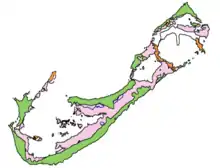
Bermuda consists of more than 150 limestone islands, but especially 5 main islands, along the southern margin of the Bermuda Platform, which is one of three topographic highs found on the Bermuda Pedestal. This Bermuda Pedestal sits atop the Bermuda Rise, a mid-basin swell surrounded by abyssal plains. Initial uplift of this rise occurred in the Middle to Late Eocene and concluded by the Late Oligocene, when it subsided below sea level. The volcanic rocks associated with this rise are tholeiitic lavas and intrusive lamprophyre sheets, which form a volcanic basement, on average, 50 metres (165') below the island carbonate surface.[59]
The limestones of Bermuda consist of biocalcarenites with minor conglomerates. The portion of Bermuda above sea level consists of rocks deposited by aeolian processes. These eolianites are actually the type locality, and formed during interglaciations, and are laced by red paleosols, also referred to as geosols or terra rossas, indicative of Saharan atmospheric dust and forming during glacial stages. The stratigraphic column starts with the Walsingham Formation, overlain by the Castle Harbour Geosol, the Lower and Upper Town Hill Formations separated by the Harbour Road Geosol, the Ord Road Geosol, the Belmont Formation, the Shore Hills Geosol, the Rocky Bay Formation, and the Southampton Formation.[59]
The older eolianite ridges (Older Bermuda) are more rounded and subdued compared to the outer coastline (Younger Bermuda). Thus, post deposition morphology includes chemical erosion, with inshore water bodies demonstrating much of Bermuda is partially drowned Pleistocene karst. The Walsingham Formation is a clear example, constituting the cave district around Castle Harbour. The Upper Town Hill Formation forms the core of the Main Island, and prominent hills such as Town Hill, Knapton Hill, and St. David's Lighthouse, while the highest hills, Gibbs Hill Lighthouse, are due to the Southampton Formation.[59]
Bermuda has two major aquifers, the Langton Aquifer located within the Southampton, Rocky Bay and Belmont Formations, and the Brighton Aquifer located within the Town Hill Formation. Four freshwater lenses occur in Bermuda, with the Central Lens being the largest on Main Island, containing an area of 7.2 km2 (1800 acres) and a thickness greater than 10 metres (30').[59]
Climate

Bermuda has a tropical rainforest climate (Köppen climate classification: Af), bordering very closely on a humid subtropical climate (Köppen climate classification: Cfa). Bermuda is warmed by the nearby Gulf Stream, and low latitude. The islands may experience modestly cooler temperatures in January, February, and March [average 17 °C (63 °F)].[8] There has never been snow, a frost or freeze on record in Bermuda.[60]
Summertime heat index in Bermuda can be high, although mid-August temperatures rarely exceed 30 °C (86 °F). The highest recorded temperature was 34 °C (93 °F) in August 1989.[61] The average annual temperature of the Atlantic Ocean around Bermuda is 22.8 °C (73.0 °F), from 18.6 °C (65.5 °F) in February to 28.2 °C (82.8 °F) in August.[62]
Bermuda is in the hurricane belt.[1] Along the Gulf Stream, it is often directly in the path of hurricanes recurving in the westerlies, although they usually begin to weaken as they approach Bermuda, whose small size means that direct landfalls of hurricanes are rare. The most recent hurricanes to cause significant damage to Bermuda were category 2 Hurricane Gonzalo on 18 October 2014 and category 3 Hurricane Nicole on 14 October 2016, both of which struck the island directly. Hurricane Paulette directly hit the island in 2020. Before that, Hurricane Fabian on 5 September 2003 was the last major hurricane to hit Bermuda directly.
With no rivers or freshwater lakes, the only source of fresh water is rainfall, which is collected on roofs and catchments (or drawn from underground lenses) and stored in tanks.[1] Each dwelling usually has at least one of these tanks forming part of its foundation. The law requires that each household collect rainwater that is piped down from the roof of each house. Average monthly rainfall is highest in October, at over 6 inches (150 mm), and lowest in April and May.
Access to biocapacity in Bermuda is much lower than world average. In 2016, Bermuda had 0.14 global hectares [63] of biocapacity per person within its territory, far lower than the world average of 1.6 global hectares per person.[64] In 2016 Bermuda used 7.5 global hectares of biocapacity per person—their ecological footprint of consumption. This means they use much more biocapacity than Bermuda contains. As a result, Bermuda is running a biocapacity deficit.[63]
| Climate data for Hamilton – capital of Bermuda (L.F. Wade International Airport) 1981–2010, extremes 1949–2010 | |||||||||||||
|---|---|---|---|---|---|---|---|---|---|---|---|---|---|
| Month | Jan | Feb | Mar | Apr | May | Jun | Jul | Aug | Sep | Oct | Nov | Dec | Year |
| Record high °C (°F) | 25.4 (77.7) |
26.1 (79.0) |
26.1 (79.0) |
27.2 (81.0) |
30.0 (86.0) |
32.2 (90.0) |
33.1 (91.6) |
33.9 (93.0) |
33.2 (91.8) |
31.7 (89.0) |
28.9 (84.0) |
26.7 (80.0) |
33.9 (93.0) |
| Average high °C (°F) | 20.7 (69.3) |
20.4 (68.7) |
20.8 (69.4) |
22.2 (72.0) |
24.6 (76.3) |
27.5 (81.5) |
29.7 (85.5) |
30.1 (86.2) |
29.1 (84.4) |
26.7 (80.1) |
23.9 (75.0) |
21.7 (71.1) |
24.8 (76.6) |
| Daily mean °C (°F) | 18.3 (64.9) |
18.0 (64.4) |
18.2 (64.8) |
19.6 (67.3) |
22.0 (71.6) |
25.0 (77.0) |
27.2 (81.0) |
27.6 (81.7) |
26.6 (79.9) |
24.4 (75.9) |
21.6 (70.9) |
19.5 (67.1) |
22.3 (72.2) |
| Average low °C (°F) | 15.8 (60.4) |
15.4 (59.7) |
15.8 (60.4) |
17.2 (63.0) |
19.8 (67.6) |
22.8 (73.0) |
24.9 (76.8) |
25.1 (77.2) |
24.3 (75.7) |
22.1 (71.8) |
19.3 (66.7) |
17.2 (63.0) |
19.9 (67.9) |
| Record low °C (°F) | 7.2 (45.0) |
6.3 (43.3) |
7.2 (45.0) |
8.9 (48.0) |
12.1 (53.8) |
15.2 (59.4) |
16.1 (61.0) |
20.0 (68.0) |
18.9 (66.0) |
14.4 (58.0) |
12.4 (54.3) |
9.1 (48.4) |
6.3 (43.3) |
| Average precipitation mm (inches) | 139 (5.47) |
124 (4.87) |
120 (4.72) |
106 (4.17) |
89 (3.52) |
120 (4.71) |
132 (5.21) |
162 (6.38) |
129 (5.09) |
160 (6.31) |
99 (3.88) |
110 (4.33) |
1,490 (58.66) |
| Average precipitation days (≥ 0.01 inch) | 18 | 16 | 16 | 12 | 10 | 11 | 13 | 15 | 14 | 15 | 14 | 15 | 169 |
| Average relative humidity (%) | 73 | 73 | 73 | 74 | 79 | 81 | 80 | 79 | 77 | 74 | 72 | 72 | 76 |
| Mean monthly sunshine hours | 142.9 | 144.5 | 185.7 | 228.1 | 248.1 | 257.2 | 281.0 | 274.1 | 220.1 | 197.5 | 170.3 | 142.5 | 2,492 |
| Source: Bermuda Weather Service (sun, 1999–2010)[62][65] | |||||||||||||
Flora and fauna
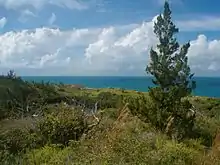
When discovered, Bermuda was uninhabited by humans and mostly dominated by forests of Bermuda cedar, with mangrove marshes along its shores.[66] Only 165 of the island's current 1,000 vascular plant species are considered native; fifteen of those, including the eponymous cedar, are endemic.[67] The semi-tropical climate of Bermuda allowed settlers to introduce many species of trees and plants to the island. Today, many types of palm trees, fruit trees, and bananas grow on Bermuda, though the cultivated coconut palms are considered non-native and may be removed. The country contains the Bermuda subtropical conifer forests terrestrial ecoregion.[68]
The only indigenous mammals of Bermuda are five species of bat, all of which are also found in the eastern United States: Lasionycteris noctivagans, Lasiurus borealis, Lasiurus cinereus, Lasiurus seminolus and Perimyotis subflavus.[69] Other commonly known fauna of Bermuda include its national bird, the Bermuda petrel or cahow, which was rediscovered in 1951 after having been thought extinct since the 1620s.[70] The cahow is important as an example of a Lazarus species, hence the government has a programme to protect it, including the restoration of its habitat areas.
The Bermuda skink (or rock lizard) was long thought to have been the only indigenous land vertebrate of Bermuda, discounting the marine turtles that lay their eggs on its beaches. However, scientists have recently discovered through genetic DNA studies that a species of turtle, the diamondback terrapin, previously thought to have been introduced to the archipelago, actually pre-dated the arrival of humans.[71] As this species spends most of its time in brackish ponds, some argue that it should be classified as a land vertebrate to compete with the skink's unique status.
Demographics
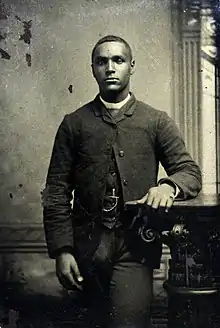
Bermuda's 2016 Census put Bermuda's population at 63,779 and, with an area of 53.2 km2 (20.5 sq mi), it has a calculated population density of 1201/km2 (3,111/mi2).[2] As of July 2018, the population is estimated to be 71,176.[1]
The racial makeup of Bermuda as recorded by the 2016 census, was 52% Black, 31% White, 9% multiracial, 4% Asian, and 4% other races, although these numbers are based on self-identification. The majority of those who answered "black" have any mixture of black, white or other ancestry. Native-born Bermudians made up 70% of the population, compared to 30% non-natives.[2]
The island experienced large-scale immigration over the 20th century, especially after the Second World War. Bermuda has a diverse population including both those with relatively deep roots in Bermuda extending back for centuries, and newer communities whose ancestry results from recent immigration, especially from Britain, North America, the West Indies, and the Portuguese Atlantic islands (especially the Azores and Madeira), although these groups are steadily merging. About 64% of the population identified themselves with Bermudian ancestry in 2010, which was an increase from the 51% who did so in the 2000 census. Those identifying with British ancestry dropped by 1% to 11% (although those born in Britain remain the largest non-native group at 3,942 persons). The number of people born in Canada declined by 13%. Those who reported West Indian ancestry were 13%. The number of people born in the West Indies actually increased by 538. A significant segment of the population is of Portuguese ancestry (25%), the result of immigration over the past 160 years,[72] of whom 79% have residency status. In June 2018, Premier Edward David Burt announced that 4 November 2019 "will be declared a public holiday to mark the 170th anniversary of the arrival of the first Portuguese immigrants in Bermuda" due to the significant impact that Portuguese immigration has had on the territory.[73] Those first immigrants arrived from Madeira aboard the vessel the Golden Rule on 4 November 1849.[74]
There are also several thousand expatriate workers, principally from Britain, Canada, the West Indies, South Africa and the United States, who reside in Bermuda. They are primarily engaged in specialised professions such as accounting, finance, and insurance. Others are employed in various trades, such as hotels, restaurants, construction, and landscaping services. Of the total workforce of 38,947 persons in 2005, government employment figures stated that 11,223 (29%) were non-Bermudians.[75]
Languages
The predominant language on Bermuda is Bermudian English.[1] It exhibits characteristics of English as spoken on the Atlantic Seaboard of the United States of America (especially in the region around Virginia), in the Canadian Maritimes, southern England, and parts of the British West Indies. There had been noticeable variation in Bermudian English depending on the part of Bermuda and the demographic of the speaker. Much of the population has adopted trans-Atlantic English over the latter decades of the twentieth century, while immigration has affected certain areas more than others. Many West Indian workers immigrated to Bermuda during the twentieth century, starting with hundreds of labourers brought in for the expansion of the Royal Naval Dockyard at the West End at the start of the century. Many others immigrated later in the century, settling mostly in Pembroke Parish and western Devonshire Parish, north of the City of Hamilton, and the "back of town" (of Hamilton) dialect and the English spoken by many blacks at the West End consequently reflects this. The West End also absorbed large numbers of civilian shipwrights and other workers from Britain who were employed at the dockyard until it was reduced to a base in 1951. The central parishes also absorbed considerable numbers of white immigrants from Britain and elsewhere, especially in the years following the Second World War (when the local government loosened immigration laws to encourage white immigration to counter the black immigration from the West Indies), speaking various varieties of Southern England English, Northern England English, and Scots, et cetera. The central parishes were also where most immigrants from Portuguese territories since the 1840s have settled, and many Bermudians in this area especially speak a Portuguese-influenced Bermudian English as a badge of pride. The East End of Bermuda, which became increasingly cut off from investment and development after the capital moved from St. George's to Hamilton in 1815, has seen the least immigration during the course of the twentieth century, with the least effect on the way English is spoken there, though the introduction of motor vehicles in 1948 has led to considerable spread of previously more isolated populations throughout Bermuda. The English of the St. David's Islanders, while often derided, is generally perceived as the most authentic form of Bermudian English.
British English spellings and conventions are used in print media and formal written communications.[76] Portuguese is also spoken by migrants from the Azores and Madeira and their descendants.[1][77]
Religion
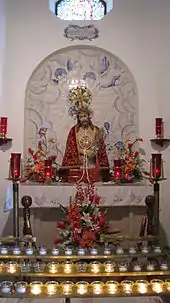
Religion in Bermuda (2010)[78]
Christianity is by far the largest religion on Bermuda.[1] Various Protestant denominations are dominant at 46.2% (including Anglican 15.8%, African Methodist Episcopal 8.6%, Seventh Day Adventist 6.7%, Pentecostal 3.5%, Methodist 2.7%, Presbyterian 2.0%, Church of God 1.6%, Baptist 1.2%, Salvation Army 1.1%, Brethren 1.0%, other Protestant 2.0%).[1] Roman Catholics form 14.5%, Jehovah's Witnesses 1.3%, and other Christians 9.1%.[1] The rest of the population are Muslim 1%, other 3.9%, none 17.8%, or unspecified 6.2% (2010 est.).[1]
The Anglican Church of Bermuda, an Anglican Communion diocese that is separate from the Church of England, operates the oldest non-Catholic parish in the New World, St. Peter's Church. Catholics in the Bahamas are served by a single Latin diocese, the Diocese of Hamilton in Bermuda.
Politics
Bermuda is an Overseas Territory of the United Kingdom, and the Government of the United Kingdom is the sovereign government.[1] Executive authority in Bermuda is vested in the British monarch (currently Elizabeth II) and is exercised on her behalf by the governor of Bermuda.[1] The governor is appointed by the queen on the advice of the British Government. Since December 2020, the governor is Rena Lalgie; she was sworn in on 14 December 2020.[79] There is also a deputy governor (currently Alison Crocket).[79] Defence and foreign affairs are the responsibility of the United Kingdom, which also retains responsibility to ensure good government and must approve any changes to the Constitution of Bermuda. Bermuda is Britain's oldest overseas territory. Although the House of Commons remains the sovereign Parliament, in 1620, a Royal Proclamation granted Bermuda limited self-governance; delegating to the House of Assembly of the Parliament of Bermuda the internal legislation of the colony. The Parliament of Bermuda is the fifth oldest legislature in the world, behind the Parliament of England, the Tynwald of the Isle of Man, the Althing of Iceland, and the Sejm of Poland.[80]
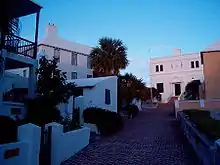
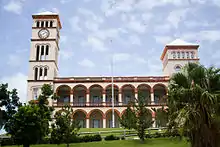
The Constitution of Bermuda came into force in 1968 and has been amended several times since then.[1] The head of government is the premier of Bermuda; a cabinet is nominated by the premier and appointed officially by the governor.[1] The legislative branch consists of a bicameral parliament modelled on the Westminster system.[1] The Senate is the upper house, consisting of 11 members appointed by the governor on the advice of the premier and the leader of the opposition. The House of Assembly, or lower house, has 36 members, elected by the eligible voting populace in secret ballot to represent geographically defined constituencies.[1]
Although British colonials (today, British Overseas Territories Citizens) always possessed the right to vote or stand for election to the House of Commons, no electoral district has ever been assigned to any colony, and no colony has been represented by a Peer in the House of Lords, effectively disenfranchising any British colonial not resident in the British Isles (representation in the Parliament of Bermuda is not a substitute as it is not the sovereign government, but subsidiary to it).
Elections for the Parliament of Bermuda must be called at no more than five-year intervals. The most recent took place on 18 July 2017. Following this election, the Progressive Labour Party took power, with Edward David Burt succeeding Michael Dunkley, of the One Bermuda Alliance, as Premier.[81][82][83]
There are few accredited diplomats in Bermuda. The United States maintains the largest diplomatic mission in Bermuda, comprising both the United States Consulate and the US Customs and Border Protection Services at the L.F. Wade International Airport. The United States is Bermuda's largest trading partner (providing over 71% of total imports, 85% of tourist visitors, and an estimated $163 billion of US capital in the Bermuda insurance/re-insurance industry). According to the 2016 Bermuda census 5.6% of Bermuda residents were born in the US, representing over 18% of all foreign-born persons.[84]
Nationality and Citizenship
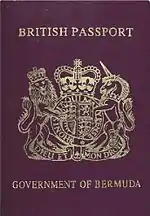
Historically, English (later British) colonials shared the same citizenship (although the Magna Carta had effectively created English citizenship, citizens were still termed subjects of the King of England or English subjects. With the union of the Kingdoms of England and Scotland, this was replaced with British Subject, which encompassed citizens throughout the sovereign territory of the British Government, including its colonies) as Britons. With no representation at the sovereign, or national, level of Government, British colonials were therefore not consulted, or required to give their consent, to a series of Acts passed by the Parliament of the United Kingdom between 1968 and 1982, which were to limit their rights and ultimately change their citizenship.
When several colonies had been elevated before the Second World War to Dominion status, collectively forming the old British Commonwealth (as distinct from the United Kingdom and its dependent colonies), their citizens remained British Subjects, and in theory, any British Subject born anywhere in the World had the same basic right to enter, reside, and work in the United Kingdom as a British Subject born in the United Kingdom whose parents were also both British Subjects born in the United Kingdom (although many governmental policies and practices acted to thwart the free exercise of these right by various groups of colonials, including Greek Cypriots). When the Dominions and an increasing number of colonies began choosing complete independence from the United Kingdom after the Second World War, the Commonwealth was transformed into a community of independent nations, each recognising the British monarch as their own head of state (creating separate monarchies with the same person occupying all of the separate Thrones; the exception being republican India).
British Subject was replaced by the British Nationality Act 1948 with Citizen of the United Kingdom and Colonies for the residents of the United Kingdom and its colonies, as well as for the Crown Dependencies. However, as it was desired to retain free movement for all Commonwealth Citizens throughout the Commonwealth, British Subject was retained as a blanket nationality shared by Citizens of the United Kingdom and Colonies (the British realm) as well as the citizens of the various other Commonwealth realms.
The inflow of people of colour to the United Kingdom during the 1940s and 1950s from both the remaining colonies and newly independent Commonwealth nations was responded to with a racist backlash that led to the passing of the Commonwealth Immigrants Act 1962, which restricted the rights of Commonwealth nationals to enter, reside and work in the United Kingdom. This Act also allowed certain colonials (primarily ethnic-Indians in African colonies) to retain Citizenship of the United Kingdom and Colonies if their colonies became independent, which was intended as a measure to ensure these persons did not become stateless if they were denied the citizenship of their newly independent nation.
Many ethnic-Indians from former African colonies (notably Kenya) subsequently relocated to the United Kingdom, in response to which the Commonwealth Immigrants Act 1968 was rapidly passed, stripping all British Subjects (including Citizens of the United Kingdom and Colonies) who were not born in the United Kingdom, and who did not have a Citizen of the United Kingdom and Colonies parent born in the United Kingdom or some other qualification (such as existing residence status), of the rights to freely enter, reside and work in the United Kingdom. This was followed by the Immigration Act 1971, which effectively divided Citizens of the United Kingdom and Colonies into two types, although their citizenship remained the same: Those from the United Kingdom itself, who retained the rights of free entry, abode, and work in the United Kingdom; and those born in the colonies (or in foreign countries to British Colonial parents), from whom those rights were denied.
The British Nationality Act 1981, which entered into force on 1 January 1983,[85] abolished British Subject status, and stripped colonials of their full British Citizenship of the United Kingdom and Colonies, replacing it with British Dependent Territories Citizenship, which entailed no right of abode or to work anywhere. This left Bermudians and most other erstwhile British colonials as British nationals without the rights of British citizenship.
The exceptions were the Gibraltarians (permitted to retain British Citizenship in order to also retain Citizenship of the European Union) and the Falkland Islanders, who were permitted to retain the same new British Citizenship that became the default citizenship for those from the United Kingdom and the Crown dependencies. As the Act was widely understood to have been passed in preparation for the 1997 handover of Hong Kong to the Peoples' Republic of China (in order to prevent ethnic-Chinese British nationals from migrating to the United Kingdom), and given the history of neglect and racism those colonies with sizeable non-European (to use the British Government's parlance) populations had endured from the British Government since the end of Empire, the changing of the default citizenship to British Dependent Territories Citizenship only for the colonies with sizeable non-European populations has been understood by Bermudians as a particularly egregious example of racism. This has been further emphasised by the sizeable percentage of white Bermudians who retained right-of-abode in the United Kingdom while very few black Bermudians did.
The stripping of birth rights from Bermudians by the British Government in 1968 and 1971, and the change of their citizenship in 1983, actually violated the rights granted them by Royal Charters at the founding of the colony. Bermuda (fully The Somers Isles or Islands of Bermuda) had been settled by the London Company (which had been in occupation of the archipelago since the 1609 wreck of the Sea Venture) in 1612, when it received its Third Royal Charter from King James I, amending the boundaries of the First Colony of Virginia far enough across the Atlantic to include Bermuda. The citizenship rights guaranteed to settlers by King James I in the original Royal Charter of the 10 April 1606, thereby applied to Bermudians:
Alsoe wee doe, for us, our heires and successors, declare by theise presentes that all and everie the parsons being our subjects which shall dwell and inhabit within everie or anie of the saide severall Colonies and plantacions and everie of theire children which shall happen to be borne within the limitts and precincts of the said severall Colonies and plantacions shall have and enjoy all liberties, franchises and immunites within anie of our other dominions to all intents and purposes as if they had been abiding and borne within this our realme of Englande or anie other of our saide dominions.
These rights were confirmed in the Royal Charter granted to the London Company's spin-off, the Company of the City of London for the Plantacion of The Somers Isles, in 1615 on Bermuda being separated from Virginia:
And wee doe for vs our heires and successors declare by these Pnts, that all and euery persons being our subjects which shall goe and inhabite wthin the said Somer Ilandes and every of their children and posterity which shall happen to bee borne within the limits thereof shall haue and enjoy all libertyes franchesies and immunities of free denizens and natural subjectes within any of our dominions to all intents and purposes, as if they had beene abiding and borne wthin this our Kingdome of England or in any other of our Dominions
Bermuda is not the only territory whose citizenship rights were laid down in a Royal Charter. In regards to St. Helena, Lord Beaumont of Whitley in the House of Lords debate on the British Overseas Territories Bill on the 10 July 2001,[88] stated:
Citizenship was granted irrevocably by Charles I. It was taken away, quite wrongly, by Parliament in surrender to the largely racist opposition to immigration at the time.
Some Conservative Party backbenchers stated that it was the unpublished intention of the Conservative British Government to return to a single citizenship for the United Kingdom and all of the remaining territories once Hong Kong had been handed over to China. Whether this was so will never be known as by 1997 the Labour Party was in Government. The Labour Party had declared prior to the election that the colonies had been ill-treated by the British Nationality Act 1981, and it had made a pledge to return to a single citizenship for the United Kingdom and the remaining territories part of its election manifesto. Other matters took precedence, however, and this commitment was not acted upon during Labour's first term in Government. The House of Lords, in which many former colonial Governors sat (including former Governor of Bermuda Lord Waddington), lost patience and tabled and passed its own bill, then handed it down to the House of Commons to confirm in 2001. As a result, the British Dependent Territories were renamed the British Overseas Territories in 2002 (the term dependent territory had caused much ire in the former colonies, especially well-heeled and self-reliant Bermuda, as it implied not only that British Dependent Territories Citizens were other than British, but that their relationship to Britain and to real British people was both inferior and parisitic).[89][90][91]
At the same time, although Labour had promised a return to a single citizenship for the United Kingdom, Crown dependencies, and all remaining territories, British Dependent Territories Citizenship, renamed British Overseas Territories Citizenship, remained the default citizenship for the territories, other than the Falkland Islands and Gibraltar (for which British Citizenship is still the default citizenship). The bars to residence and work in the United Kingdom that had been raised against holders of British Dependent Territories Citizenship by The British Nationality Act 1981 were, however, removed, and British Citizenship was made attainable by simply obtaining a second British passport with the citizenship recorded as British Citizen (requiring a change to passport legislation as prior to 2002, it had been illegal to possess two British Passports).[92]
Administrative divisions
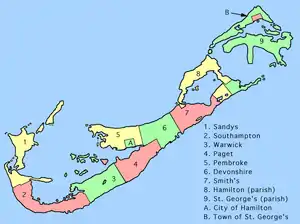
Bermuda is divided into nine parishes and two incorporated municipalities.[1]
Bermuda's nine parishes are:
Bermuda's two incorporated municipalities are:
- Hamilton (city)
- St George's (town)
Bermuda's two informal villages are:
Jones Village in Warwick, Cashew City (St. George's), Claytown (Hamilton), Middle Town (Pembroke), and Tucker's Town (St. George's) are neighbourhoods (the original settlement at Tucker's Town was replaced with a golf course in the 1920s and the few houses in the area today are mostly on the water's edge of Castle Harbour or the adjacent peninsula); Dandy Town and North Village are sports clubs, and Harbour View Village is a small public housing development.
International relations
As a British Overseas Territory, Bermuda does not have a seat in the United Nations; it is represented by Britain in matters of foreign affairs.[1] To promote its economic interests abroad, Bermuda maintains representative offices in cities such as London[93] and Washington, D.C.[94]
Bermuda's proximity to the US had made it attractive as the site for summit conferences between British prime ministers and US presidents. The first summit was held in December 1953, at the insistence of Prime Minister Winston Churchill, to discuss relations with the Soviet Union during the Cold War. Participants included Churchill, US president Dwight D. Eisenhower and French premier Joseph Laniel.[95]
In 1957 a second summit conference was held. The British prime minister, Harold Macmillan, arrived earlier than President Eisenhower, to demonstrate they were meeting on British territory, as tensions were still high regarding the previous year's conflict over the Suez Canal. Macmillan returned in 1961 for the third summit with President John F. Kennedy. The meeting was called to discuss Cold War tensions arising from construction of the Berlin Wall.[96]
The most recent summit conference in Bermuda between the two powers occurred in 1990, when British prime minister Margaret Thatcher met US president George H. W. Bush.[96]
Direct meetings between the president of the United States and the premier of Bermuda have been rare. The most recent meeting was on 23 June 2008, between Premier Ewart Brown and President George W. Bush. Prior to this, the leaders of Bermuda and the United States had not met at the White House since a 1996 meeting between Premier David Saul and President Bill Clinton.[97]
Bermuda has also joined several other jurisdictions in efforts to protect the Sargasso Sea.[98]
In 2013 and 2017 Bermuda chaired the United Kingdom Overseas Territories Association.[99][100]
Asylum offer to four former Guantánamo detainees
On 11 June 2009, four Uyghurs who had been held in the United States Guantánamo Bay detention camp, in Cuba, were transferred to Bermuda.[101][102][103][104] The four men were among 22 Uyghurs who claimed to be refugees who were captured in 2001 in Pakistan after fleeing the American aerial bombardment of Afghanistan. They were accused of training to assist the Taliban's military. They were cleared as safe for release from Guantánamo in 2005 or 2006, but US domestic law prohibited deporting them back to China, their country of citizenship, because the US government determined that China was likely to violate their human rights.
In September 2008, the men were cleared of all suspicion and Judge Ricardo Urbina in Washington ordered their release. Congressional opposition to their admittance to the United States was very strong[101] and the US failed to find a home for them until Bermuda and Palau agreed to accept the 22 men in June 2009.
The secret bilateral discussions that led to prisoner transfers between the US and the devolved Bermuda government sparked diplomatic ire from the United Kingdom, which was not consulted on the move despite Bermuda being a British territory. The British Foreign Office issued the following statement:
We've underlined to the Bermuda Government that they should have consulted with the United Kingdom as to whether this falls within their competence or is a security issue, for which the Bermuda Government do not have delegated responsibility. We have made clear to the Bermuda Government the need for a security assessment, which we are now helping them to carry out, and we will decide on further steps as appropriate.[105]
In August 2018, the four Uyghurs were granted limited citizenship in Bermuda. The men now have the same rights as Bermudians except the right to vote.[106]
Caribbean Community
The British Government originally grouped Bermuda with North America (given its proximity, and Bermuda having been established as an extension of the Colony of Virginia, and with Carolina Colony, the nearest landfall, having been settled from Bermuda). After the acknowledgement by the British Government of the independence of thirteen continental colonies (including Virginia and the Carolinas) in 1783, Bermuda was generally grouped regionally by the British Government with The Maritimes and Newfoundland and Labrador (and more widely, with British North America), substantially nearer to Bermuda than is the Caribbean. However, with the confederation of Canada and the Maritimes and their attainment of Dominion status in the 1860s, the British political, naval and military hierarchy in Bermuda became increasingly separated from that of the Canadian Government (the Royal Navy headquarters for the North America and West Indies Station had spent summers at Halifax, Nova Scotia, and winters at Bermuda, but settled at Bermuda year round with the Royal Naval Dockyard, Halifax finally being transferred to the Royal Canadian Navy in 1907, and the Bermuda Garrison had been placed under the military Commander-in-Chief America in New York during the American War of Independence, and had been part of the Nova Scotia Command thereafter, but became the separate Bermuda Command from the 1860s with the Major-General or Lieutenant-General appointed as Commander-in-Chief of Bermuda also filling the civil role of Governor of Bermuda), and Bermuda was increasingly perceived by the British Government as in, or at least grouped for convenience with, the British West Indies (although the established Church of England in Bermuda, which from 1825 to 1839 had been attached to the See of Nova Scotia) remained part of the Diocese of Newfoundland and Bermuda until 1879, when the Synod of the Church of England in Bermuda was formed and a Diocese of Bermuda became separate from the Diocese of Newfoundland, but continued to be grouped under the Bishop of Newfoundland and Bermuda until 1919, when Newfoundland and Bermuda each received its own bishop). Newfoundland attained Dominion status in 1907, leaving the nearest other territories to Bermuda that were still within the British Realm (a term which replaced Dominion in 1952 as the dominions and many colonies moved towards full political independence) as the British colonies in the British West Indies.
Bermuda became an associate member of the Caribbean Community (CARICOM) in July 2003, despite not being in the Caribbean region.[107][108][109]
CARICOM is a socio-economic bloc of nations in or near the Caribbean Sea established in 1973. Other outlying member states include the Co-operative Republic of Guyana and the Republic of Suriname in South America, and Belize in Central America. The Turks and Caicos Islands, an associate member of CARICOM, and the Commonwealth of The Bahamas, a full member of CARICOM, are in the Atlantic, but close to the Caribbean. Other nearby nations or territories, such as the United States, are not members (although the US Commonwealth of Puerto Rico has observer status, and the United States Virgin Islands announced in 2007 that they would seek ties with CARICOM). Bermuda has minimal trade with the Caribbean region, and little in common with it economically, being roughly a thousand miles from the Caribbean Sea; it joined CARICOM primarily to strengthen cultural links with the region.
Among some scholars, "the Caribbean" can be a socio-historical category, commonly referring to a cultural zone characterised by the legacy of slavery (a characteristic Bermuda shared with the Caribbean and the US) and the plantation system (which did not exist in Bermuda). It embraces the islands and parts of the neighbouring continent, and may be extended to include the Caribbean Diaspora overseas.[110]
The PLP, which was the party in government when the decision was made to join CARICOM, has been dominated for decades by West Indians and their descendants. The prominent roles of West Indians among Bermuda's black politicians and labour activists predated party politics in Bermuda, as exemplified by E. F. Gordon.[111][112] The late PLP leader, Dame Lois Browne-Evans, and her Trinidadian-born husband, John Evans (who co-founded the West Indian Association of Bermuda in 1976),[113] were prominent members of this group. They have emphasised Bermuda's cultural connections with the West Indies. Many Bermudians, both black and white, who lack family connections to the West Indies have objected to this emphasis.[113][114][115]
The decision to join CARICOM stirred up a huge amount of debate and speculation among the Bermudian community and politicians.[116][117] Opinion polls conducted by two Bermudian newspapers, The Royal Gazette and The Bermuda Sun, showed that clear majorities of Bermudians were opposed to joining CARICOM.[118]
The UBP, which had been in government from 1968 to 1998, argued that joining CARICOM was detrimental to Bermuda's interests:[119]
- Bermuda's trade with the West Indies is negligible, its primary economic partners being the US, Canada, and UK (it has no direct air or shipping links to Caribbean islands);
- CARICOM is moving towards a single economy;
- the Caribbean islands are generally competitors to Bermuda's already ailing tourism industry; and
- participation in CARICOM would involve considerable investment of money and the time of government officials that could more profitably be spent elsewhere.
Military
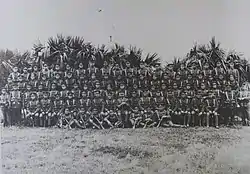

Once known as "the Gibraltar of the West" and "Fortress Bermuda", Bermuda today is defended by British forces. For the first two centuries of settlement, the most potent armed force operating from Bermuda was its merchant shipping fleet, which turned to privateering at every opportunity. The Bermuda government maintained a local (infantry) militia and fortified coastal artillery batteries manned by volunteer artillerymen. Bermuda tended toward the Royalist side during the English Civil War, being the first of six colonies to recognise Charles II as King on the execution of his father, Charles I, in 1649, and was one of those targeted by the Rump Parliament in An Act for prohibiting Trade with the Barbadoes, Virginia, Bermuda and Antego, which was passed on the 30 October 1650. With control of the "army" (the militia and coastal artillery), the colony's Royalists deposed the Governor, Captain Thomas Turner, elected John Trimingham to replace him, and exiled many of its Parliamentary-leaning Independents to settle the Bahamas under William Sayle as the Eleutheran Adventurers. Bermuda's barrier reef, coastal artillery batteries and militia provided a defence too powerful for the fleet sent in 1651 by Parliament under the command of Admiral Sir George Ayscue to capture the Royalist colonies. The Parliamentary Navy was consequently forced to blockade Bermuda for several months 'til the Bermudians negotiated a peace.
After the American Revolutionary War, Bermuda was established as the Western Atlantic headquarters of the Royal Navy. Once the Royal Navy established a base and dockyard defended by regular soldiers, however, the militias were disbanded following the War of 1812. At the end of the 19th century, the colony raised volunteer units to form a reserve for the military garrison.
Due to its isolated location in the North Atlantic Ocean, Bermuda was vital to the Allies' war effort during both world wars of the 20th century, serving as a marshalling point for trans-Atlantic convoys, as well as a naval air base. By the Second World War, both the Royal Navy's Fleet Air Arm and the Royal Air Force were operating Seaplane bases on Bermuda.
In May 1940, the US requested base rights in Bermuda from the United Kingdom, but British Prime Minister Winston Churchill was initially unwilling to accede to the American request without getting something in return.[120] In September 1940, as part of the Destroyers for Bases Agreement, the UK granted the US base rights in Bermuda. Bermuda and Newfoundland were not originally included in the agreement, but both were added to it, with no war material received by the UK in exchange. One of the terms of the agreement was that the airfield the US Army built would be used jointly by the US and the UK (which it was for the duration of the war, with RAF Transport Command relocating there from Darrell's Island in 1943). The US Army established the Bermuda Base Command in 1941 to co-ordinate its air, anti-aircraft, and coast artillery assets during the war. The US Navy operated a submarine base on Ordnance Island from 1942 through 1945.[48]
Construction began in 1941 of two airbases consisting of 5.8 km2 (2.2 sq mi) of land, largely reclaimed from the sea. For many years, Bermuda's bases were used by US Air Force transport and refuelling aircraft and by US Navy aircraft patrolling the Atlantic for enemy submarines, first German and, later, Soviet. The principal installation, Kindley Air Force Base on the eastern coast, was transferred to the US Navy in 1970 and redesignated Naval Air Station Bermuda. As a naval air station, the base continued to host both transient and deployed USN and USAF aircraft, as well as transitioning or deployed Royal Air Force and Canadian Forces aircraft.
The original NAS Bermuda on the west side of the island, a seaplane base until the mid-1960s, was designated as the Naval Air Station Bermuda Annex. It provided optional anchorage and/or dockage facilities for transiting US Navy, US Coast Guard and NATO vessels, depending on size. An additional US Navy compound known as Naval Facility Bermuda (NAVFAC Bermuda), a submarine-detecting SOSUS station, was located to the west of the Annex near a Canadian Forces communications facility in the Tudor Hill area; it was converted from a US Army coast artillery bunker in 1954 and operated until 1995. Although leased for 99 years, US forces withdrew in 1995, as part of the wave of base closures following the end of the Cold War.
Canada, which had operated a war-time naval base, HMCS Somers Isles, on the old Royal Navy base at Convict Bay, St George's, also established a radio-listening post at Daniel's Head in the West End of the islands during this time.
In the 1950s, after the end of World War II, the Royal Naval dockyard and the military garrison were closed. A small Royal Navy supply base, HMS Malabar, continued to operate within the dockyard area, supporting transiting Royal Navy ships and submarines until it, too, was closed in 1995, along with the American and Canadian bases.
Bermudians served in the British armed forces during both World War I and World War II. After the latter, Major-General Glyn Charles Anglim Gilbert, Bermuda's highest-ranking soldier, was instrumental in developing the Bermuda Regiment. A number of other Bermudians and their descendants had preceded him into senior ranks, including Bahamian-born Admiral Lord Gambier, and Bermudian-born Royal Marines Brigadier Harvey. When promoted to brigadier at age 39, following his wounding at the Anzio landings, Harvey became the youngest-ever Royal Marine Brigadier. The Cenotaph in front of the Cabinet Building (in Hamilton) was erected in tribute to Bermuda's Great War dead (the tribute was later extended to Bermuda's Second World War dead) and is the site of the annual Remembrance Day commemoration.
Today, the only military unit remaining in Bermuda, other than naval and army cadet corps, is the Royal Bermuda Regiment, an amalgam of the voluntary units originally formed toward the end of the 19th century. Although the Regiment's predecessors were voluntary units, the modern body is formed primarily by conscription: balloted males are required to serve for three years, two months part-time, once they turn 18.
In early 2020 Bermuda formed the Bermuda Coast Guard. Its 24-hour on-duty service includes search and rescue, counter-narcotics operations, border control, and protection of Bermuda's maritime interests. The Bermuda Coast Guard will interact with the Bermuda Regiment, Bermuda Police Service.[121]
Economy

Banking and other financial services now form the largest sector of the economy at circa 85% of GDP, with tourism being the second largest industry at 5%.[1][5] Industrial and agriculture activities occur, however these are on a very limited scale and Bermuda is heavily reliant on imports.[1] Living standards are high and as of 2019 Bermuda has the 6th highest GDP per capita in the world.[1]
1890s to 1920s economy severely affected by lily virus
Early Easter Lily bulb exports to New York—then vital financially for Bermuda—became badly diseased from the late 19th century to the mid-1920s. Lawrence Ogilvie, the Department of Agriculture plant pathologist saved the industry by identifying the problem as a virus (not aphid damage as previously thought) and instituting controls in the fields and packing houses. There was a marked improvement in exporting 23 cases of lily bulbs in 1918 to 6043 cases in 1927 from the then 204 lily fields.[122] Still in his 20s, Ogilvie was professionally honoured by an article in Nature magazine.[123] The lily export trade continued to flourish until the 1940s when the Japanese captured much of the market.
Currency
In 1970 the country switched its currency from the Bermudian pound to the Bermudian dollar, which is pegged at par with the US dollar. US notes and coins are used interchangeably with Bermudian notes and coins within the islands for most practical purposes; however, banks levy an exchange rate fee for the purchase of US dollars with Bermudian dollars.[124] The Bermuda Monetary Authority is the issuing authority for all banknotes and coins, and regulates financial institutions. The Royal Naval Dockyard Museum holds a permanent exhibition of Bermuda notes and coins.[125]
Finance
Bermuda is an offshore financial centre, which results from its minimal standards of business regulation/laws and direct taxation on personal or corporate income. It has one of the highest consumption taxes in the world and taxes all imports in lieu of an income tax system. Bermuda's consumption tax is equivalent to local income tax to local residents and funds government and infrastructure expenditures. The local tax system depends upon import duties, payroll taxes and consumption taxes. Foreign private individuals cannot easily open bank accounts or subscribe to mobile phone or internet services.[126]
Having no corporate income tax, Bermuda is a popular tax avoidance location. Google, for example, is known to have shifted over $10 billion in revenue to its Bermuda subsidiary utilising the Double Irish and Dutch Sandwich tax avoidance strategies, reducing its 2011 tax liability by $2 billion.[127]
Large numbers of leading international insurance companies operate in Bermuda.[128] Those internationally owned and operated businesses that are physically based in Bermuda (around four hundred) are represented by the Association of Bermuda International Companies (ABIC). In total, over 15,000 exempted or international companies are currently registered with the Registrar of Companies in Bermuda, most of which hold no office space or employees.
There are four hundred securities listed on the Bermuda Stock Exchange (BSX), of which almost three hundred are offshore funds and alternative investment structures attracted by Bermuda's regulatory environment. The Exchange specialises in listing and trading of capital market instruments such as equities, debt issues, funds (including hedge fund structures) and depository receipt programmes. The BSX is a full member of the World Federation of Exchanges and is located in an OECD member nation. It also has Approved Stock Exchange status under Australia's Foreign Investment Fund (FIF) taxation rules and Designated Investment Exchange status by the UK's Financial Services Authority.
Four banks operate in Bermuda,[129] having consolidated total assets of $24.3 billion (March 2014).[130]
Tourism
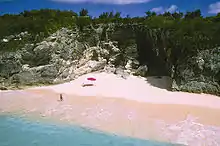
Tourism is Bermuda's second-largest industry, with the island attracting over half a million visitors annually, of whom more than 80% are from the United States.[1] Other significant sources of visitors are from Canada and the United Kingdom. Tourists arrive either by cruise ship or by air at L.F. Wade International Airport, the only airport on the island.[131] However, the sector is vulnerable to external shocks, such as the 2008 recession.[1]
Housing
The affordability of housing became a prominent issue during Bermuda's business peak in 2005 but has softened with the decline of Bermuda's real estate prices. The World Factbook lists the average cost of a house in June 2003 as $976,000,[132] while real estate agencies have claimed that this figure had risen to between $1.6 million[133] and $1.845 million by 2007,[134] though such high figures have been disputed.[135]
Education
The Bermuda Education Act 1996 requires that only three categories of schools can operate in the Bermuda Education system:[136]
- An aided school has all or a part of its property vested in a body of trustees or board of governors and is partially maintained by public funding or, since 1965 and the desegregation of schools, has received a grant-in-aid out of public funds.
- A maintained school has the whole of its property belonging to the Government and is fully maintained by public funds.
- A private school, not maintained by public funds and which has not, since 1965 and the desegregation of schools, received any capital grant-in-aid out of public funds. The private school sector consists of six traditional private schools, two of which are religious schools, and the remaining four are secular with one of these being a single-gender school and another a Montessori school. Also, within the private sector there are a number of home schools, which must be registered with the government and receive minimal government regulation. The only boys' school opened its doors to girls in the 1990s, and in 1996, one of the aided schools became a private school.
Prior to 1965, the Bermuda school system was racially segregated. When the desegregation of schools was enacted in 1965, two of the formerly maintained "white" schools and both single-sex schools opted to become private schools. The rest became part of the public school system and were either aided or maintained.
There are 38 schools in the Bermuda Public School System, including 10 preschools, 18 primary schools, 5 middle schools, 2 senior schools (The Berkeley Institute and Cedarbridge Academy), 1 school for students with physical and cognitive challenges, and 1 for students with behavioural problems.[137] There is one aided primary school, two aided middle schools, and one aided senior school. Since 2010, Portuguese has been taught as an optional foreign language in the Bermudian school system.[138][139]
For higher education, the Bermuda College offers various associate degrees and other certificate programmes.[140] Bermuda does not have any Bachelor-level colleges or universities. Bermuda's graduates usually attend Bachelor-level universities in the United States, Canada and the United Kingdom.[141]
In May 2009, the Bermudian Government's application was approved to become a contributory member of the University of the West Indies (UWI). Bermuda's membership enabled Bermudian students to enter the university at an agreed-upon subsidised rate by 2010. UWI also agreed that its Open Campus (online degree courses) would become open to Bermudian students in the future, with Bermuda becoming the 13th country to have access to the Open Campus.[142] In 2010, it was announced that Bermuda would be an "associate contributing country" due to local Bermudan laws.[143]
Culture
Bermuda's culture is a mixture of the various sources of its population: Native American, Spanish-Caribbean, English, Irish, and Scots cultures were evident in the 17th century, and became part of the dominant British culture. English is the primary and official language. Due to 160 years of immigration from Portuguese Atlantic islands (primarily the Azores, though also from Madeira and the Cape Verde Islands), a portion of the population also speaks Portuguese. There are strong British influences, together with Afro-Caribbean ones.
A second wave of immigration from the West Indies was sustained throughout the 20th century; the more recent arrivals have primarily come from English-speaking countries, also bringing aspects of their cultures. This new infusion of West Indians has both accelerated social and political change, and diversified Bermuda's culture.
The first notable, and historically important, book credited to a Bermudian was The History of Mary Prince, a slave narrative by Mary Prince. It is thought to have contributed to the abolition of slavery in the British Empire. Ernest Graham Ingham, an expatriate author, published his books at the turn of the 19th and 20th centuries. In the 20th century, numerous books were written and published locally, though few were directed at a wider market than Bermuda. (The latter consisted primarily of scholarly works rather than creative writing). The novelist Brian Burland (1931– 2010) achieved a degree of success and acclaim internationally. More recently, Angela Barry has won critical recognition for her published fiction.
Arts
Music and dance are an important part of Bermudian culture. West Indian musicians introduced calypso music when Bermuda's tourist industry was expanded with the increase of visitors brought by post-Second World War aviation. Local icons, The Talbot Brothers, performed calypso music for many decades both in Bermuda and the United States, and appeared on the Ed Sullivan Show. While calypso appealed more to tourists than to the local residents, reggae has been embraced by many Bermudians since the 1970s with the influx of Jamaican immigrants.
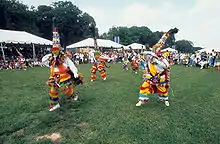
Noted Bermudian musicians include operatic tenor Dr. Gary Burgess; jazz pianist Lance Hayward; singer-songwriter and poet, Heather Nova, and her brother Mishka, reggae musician; classical musician and conductor Kenneth Amis; and more recently, dancehall artist Collie Buddz.
The dances of the colourful Gombey dancers, seen at many events, are strongly influenced by African, Caribbean, Native American and British cultural traditions. In summer 2001, they performed at the Smithsonian Folklife Festival on the National Mall in Washington, D.C., United States. These Gombey Dancers continue to showcase their work for locals and visitors during the Harbour Nights festival on Bermuda's Front Street every Wednesday evening (during the summer months) and draw very large crowds.
Bermuda's early literature was limited to the works of non-Bermudian writers commenting on the islands. These included John Smith's The Generall Historie of Virginia, New-England, and the Summer Isles (1624), and Edmund Waller's poem, "Battle of the Summer Islands" (1645).[144][145]
Bermuda is the only place name in the New World that is alluded to in the works of Shakespeare; it is mentioned in his play The Tempest, in Act 1, Scene 2, line 230: "the still-vexed Bermoothes", this being a reference to the Bermudas.
Local artwork may be viewed at several galleries around Bermuda, and watercolours painted by local artists are also on sale. Alfred Birdsey was one of the more famous and talented watercolourists; his impressionistic landscapes of Hamilton, St George's, and the surrounding sailboats, homes, and bays of Bermuda, are world-renowned. Hand-carved cedar sculptures are another speciality. One such 7 ft (2.1 m) sculpture, created by Bermudian sculptor Chesley Trott, is installed at the airport's baggage claim area. In 2010, his sculpture We Arrive was unveiled in Barr's Bay Park, overlooking Hamilton Harbour, to commemorate the freeing of slaves in 1835 from the American brig Enterprise.[146]
Local resident Tom Butterfield founded the Masterworks Museum of Bermuda Art in 1986, initially featuring works about Bermuda by artists from other countries. He began with pieces by American artists, such as Winslow Homer, Charles Demuth, and Georgia O'Keeffe, who had lived and worked on Bermuda. He has increasingly supported the development of local artists, arts education, and the arts scene.[147] In 2008, the museum opened its new building, constructed within the Botanical Gardens.[148]
Bermuda hosts an annual international film festival, which shows many independent films. One of the founders is film producer and director Arthur Rankin, Jr., co-founder of the Rankin/Bass production company.[149]
Bermudian model Gina Swainson was crowned "Miss World" in 1979.[150]
Sports
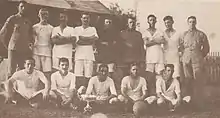
Many sports popular today were formalised by British public schools and universities in the 19th century. These schools produced the civil servants and military and naval officers required to build and maintain the British Empire, and team sports were considered a vital tool for training their students to think and act as part of a team. Former public schoolboys continued to pursue these activities, and founded organisations such as the Football Association (FA). Today's association of football with the working classes began in 1885 when the FA changed its rules to allow professional players. The Bermuda national football team managed to qualify to the 2019 CONCACAF Gold Cup, the country's first ever major football competition.
The professionals soon displaced the amateur ex-Public schoolboys. Bermuda's role as the primary Royal Navy base in the Western Hemisphere, with an army garrison to match, ensured that the naval and military officers quickly introduced the newly formalised sports to Bermuda, including cricket, football, rugby football, and even tennis and rowing (rowing did not adapt well from British rivers to the stormy Atlantic. The officers soon switched to sail racing, founding the Royal Bermuda Yacht Club). Once these sports reached Bermuda, they were eagerly adopted by Bermudians.
Bermuda's national cricket team participated in the Cricket World Cup 2007 in the West Indies. Their most famous player is a 130 kilograms (290 lb) police officer named Dwayne Leverock. But India defeated Bermuda and set a record of 413 runs in a One-Day International (ODI). Bermuda were knocked out of the World Cup. Also very well known is David Hemp, a former captain of Glamorgan in English first class cricket. The annual "Cup Match" cricket tournament between rival parishes St George's in the east and Somerset in the west is the occasion for a popular national holiday. This tournament began in 1872 when Captain Moresby of the Royal Navy introduced the game to Bermuda, holding a match at Somerset to mark forty years since the unjust thraldom of slavery. The East End versus West End rivalry resulted from the locations of the St. George's Garrison (the original army headquarters in Bermuda) on Barrack Hill, St. George's, and the Royal Naval Dockyard at Ireland Island. Moresby founded the Somerset Cricket Club which plays the St. George's Cricket Club in this game (the membership of both clubs has long been mostly civilian).[151]
In 2007, Bermuda hosted the 25th PGA Grand Slam of Golf. This 36-hole event was held on 16–17 October 2007, at the Mid Ocean Club in Tucker's Town. This season-ending tournament is limited to four golfers: the winners of the Masters, U.S. Open, The Open Championship and PGA Championship. The event returned to Bermuda in 2008 and 2009. One-armed Bermudian golfer Quinn Talbot was both the United States National Amputee Golf Champion for five successive years and the British World One-Arm Golf Champion.[152]
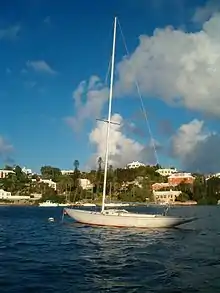
The Government announced in 2006 that it would provide substantial financial support to Bermuda's cricket and football teams. Football did not become popular with Bermudians 'til after the Second World War, though teams from the various Royal Navy, British Army Bermuda Garrison, and Royal Air Force units of Bermuda had competed annually for the Governor's Cup introduced by Major-General Sir George Mackworth Bullock in 1913. A combined team of the Bermuda Militia Artillery (BMA) and the Bermuda Militia Infantry (BMI) defeated HMS Malabar to win the cup on 21 March 1943, becoming the first team of a locally raised unit to do so, and the third British Army team to do so since 1926.[153] Bermuda's most prominent footballers are Clyde Best, Shaun Goater, Kyle Lightbourne, Reggie Lambe, Sam Nusum and Nahki Wells. In 2006, the Bermuda Hogges were formed as the nation's first professional football team to raise the standard of play for the Bermuda national football team. The team played in the United Soccer Leagues Second Division but folded in 2013.
Sailing, fishing and equestrian sports are popular with both residents and visitors alike. The prestigious Newport–Bermuda Yacht Race is a more than 100-year-old tradition, with boats racing between Newport, Rhode Island and Bermuda. In 2007, the 16th biennial Marion-Bermuda yacht race occurred. A sport unique to Bermuda is racing the Bermuda Fitted Dinghy. International One Design racing also originated in Bermuda.[154] In December 2013, Bermuda's bid to host the 2017 America's Cup was announced.
At the 2004 Summer Olympics, Bermuda competed in sailing, athletics, swimming, diving, triathlon and equestrian events. In those Olympics, Bermuda's Katura Horton-Perinchief made history by becoming the first black female diver to compete in the Olympic Games. Bermuda has had one Olympic medallist, Clarence Hill, who won a bronze medal in boxing. Bermuda also competed in Men's Skeleton at the 2006 Winter Olympics in Turin, Italy. Patrick Singleton placed 19th, with a final time of 1:59.81. Jillian Teceira competed in the Beijing Olympics in 2008. It is tradition for Bermuda to march in the Opening Ceremony in Bermuda shorts, regardless of the summer or winter Olympic celebration. Bermuda also competes in the biennial Island Games, which it hosted in 2013.
In 1998, Bermuda established its own Basketball Association.[155] Since then, its national team has taken advantage of Bermuda's advanced basketball facilities[156] and competed at the Caribbean Basketball Championship.
Healthcare
The Bermuda Hospitals Board operates the King Edward VII Memorial Hospital, located in Paget Parish, and the Mid-Atlantic Wellness Institute, located in Devonshire Parish.[157] Boston's Lahey Medical Center has an established visiting specialists program on the island which provides Bermudians and expats with access to specialists regularly on the island. There were about 6,000 hospital admissions, 30,000 emergency department attendances and 6,300 outpatient procedures in 2017.[158]
Unlike the other territories that still remain under British rule, Bermuda does not have national healthcare. Employers must provide a healthcare plan and pay for up to 50% of the cost for each employee.[159] Healthcare is a mandatory requirement and is expensive, even with the help provided by employers, though no more expensive than that which an employee in the US would typically pay for healthcare when obtained through their employer and the coverage typically far exceeds that which one may have through their employer in the US. There are only a few approved healthcare providers that offer insurance to Bermudians.[159] In 2016 these were the Bermudian government's Health Insurance Department, three other approved licensed health insurance companies, and three approved health insurance schemes (provided by the Bermudian government for its employees and by two banks).[160]
There are no paramedics on the island. The Bermuda Hospitals Board says that they were not vital in Bermuda because of its small size.[161] Nurse practitioners on the island, of which there are not many, can be granted authority to write prescriptions "under the authority of a medical practitioner".[162]
See also
References
- "North America :: Bermuda". CIA World Factbook. July 2018. Retrieved 4 February 2019.
 This article incorporates public domain material from the CIA World Factbook website https://www.cia.gov/the-world-factbook/.
This article incorporates public domain material from the CIA World Factbook website https://www.cia.gov/the-world-factbook/. - "Bermuda 2016 Census" (PDF). Bermuda Department of Statistics. December 2016. Retrieved 22 March 2020.
- "Bermuda (Economic indicators)". Data.un.org. Retrieved 22 March 2020.
- Standard time in Bermuda is four hours behind Greenwich Mean Time (GMT) (Time Zone Act). UTC is not permitted to drift more than 0.9 seconds from GMT.
- "Bermuda – History and Heritage". Smithsonian. 6 November 2007. Archived from the original on 24 May 2012. Retrieved 3 December 2008.
- "Bermuda's Tourism Industry" Tayfun King, Fast Track, BBC World News (3 November 2009).
- Rushe, George. "Bermuda". Encyclopædia Britannica. Retrieved 1 September 2015.
- Keith Forbes. "Bermuda Climate and Weather". The Royal Gazette. Retrieved 28 October 2008.
- Kara, James B. Elsner; A. Birol (1999). Hurricanes of the North Atlantic : climate and society. New York, NY [u.a.]: Oxford Univ. Press. ISBN 978-0195125085.
- The Tempest Act I Scene II
- "Bermuda | Geography, History, & Facts". Retrieved 23 August 2019.
- Morison III, Samuel (1974). The European Discovery of America: The Southern Voyages, 1492–1616. New York: Oxford University Press.
- McGovern 2018, p. 10.
- "History in Bermuda | Frommer's". Retrieved 23 August 2019.
- "Department of Community & Cultural Affairs – Portuguese Rock". communityandculture.bm.
- "The cahow: Saved from hog, rat and man". The New York Times. 2 December 1973.
- "Haunted Bermuda: 5 Ghosts You Might Meet on the Island". 2 June 2016.
- "Looking At The Tale Of The "Isle Of Devils"". Bernews. 31 October 2014.
- Mark Nicholls (3 May 2011). "Sir George Somers (1554–1610)". Encyclopedia Virginia.
- Woodward, Hobson (2009). A Brave Vessel: The True Tale of the Castaways Who Rescued Jamestown and Inspired Shakespeare's The Tempest. Viking. pp. 191–199.
- Mentz, Steve (2015). Shipwreck Modernity, Ecologies of Globalization, 1550-1719 (1st ed.). University of Minnesota Press. pp. Chapter 3. ISBN 978-1452945545.
- "Sir George Somers". Historic-uk.com. Retrieved 8 January 2021.
- name=Smithsonian>"Bermuda – History and Heritage". Smithsonian. 6 November 2007. Archived from the original on 24 May 2012. Retrieved 3 December 2008.
- "Bermuda's 400th Birthday" (PDF). Bearboa.files.wordpress.com. 11 February 2009.
- "Somers Garden". Bermuda, Bermuda-attractions.com.
- Meggs, Martin. "Developing a Small Island GIS: the Bermuda Experience". Bermuda Department of Planning.
- Keith Archibald Forbes. "Bermuda's History from 1500 to 1699". bermuda-online.org. Archived from the original on 15 July 2017. Retrieved 22 September 2007.
- "October 1650: An Act for prohibiting Trade with the Barbadoes, Virginia, Bermuda and Antego". British History Online. Retrieved 8 January 2021.
- Hore, Peter (2015). HMS Pickle: The Swiftest Ship in Nelson's Trafalgar Fleet. Naval Institute Press. ISBN 9780750964357.
- Jarvis, Michael (2010). In the Eye of All Trade. Chapel Hill: University of North Carolina Press. pp. 385–389. ISBN 9780807872840.
- Stark, James Henry (1897). Stark's Illustrated Bermuda Guide: A Description of Everything on Or about These Places of which the Visitor Or Resident May Desire Information, Including Their History, Inhabitants, Climate, Agriculture, Geology, Government and Resources. Bermuda Island (Bermuda Islands): J.H.Stark. p. 250. Retrieved 7 June 2018.
- Rigby, Neil (26 January 1984). "1984 200th Anniversary of Bermuda's first Newspaper and Postal Service". Retrieved 7 June 2018.
- "The Bermuda gazette". United States Library of Congress. Retrieved 7 June 2018.
- Howes, James: "Attack on Baltimore Launched from Bermuda in 'War of 1812'" 2005
- The Sugar Revolutions and Slavery, U.S. Library of Congress
- Camps for Boers – Bermuda. Angloboerwar.com. Retrieved 15 August 2012.
- "The Prisoner at Bermuda – Boers Attempted to Mutiny in the Course of the Voyage–Martial Law on Darrell's Island". The New York Times. 10 June 2012. Retrieved 15 August 2012.
- "Boer Prisoners Escape – Three Swim Away from Darrell's Island to the Mainland". The New York Times. 10 June 2012. Retrieved 15 August 2012.
- "Adventures of an Escaped Boer Prisoner – Arrived Here as a Stowaway on the Steamship Trinidad". The New York Times, 10 June 2012, Retrieved 15 August 2012
- Ronnie 1995, p. 37.
- Ronnie 1995, pp. 54,63.
- Ronnie 1995, pp. 65–66.
- Duffy 2014, p. 2.
- "Unusual Place – Unusual Story – Heroic Crew" (PDF). Oldqslcards.com. Retrieved 15 August 2012.
- Hodgson, Tim (25 April 2016). "Celebrating a wartime spy chief". The Royal Gazette.
- "Hamilton Princess & Beach Club, A Fairmont Managed Hotel - Luxury Hotel in Hamilton - Fairmont, Hotels & Resorts". Fairmont.com. Retrieved 8 January 2021.
- David Martin (11 November 2011). "Bermuda's WWII Espionage Role". Bernews.com. Retrieved 8 January 2021.
- "Bermuda Online: American military bases in Bermuda 1941 to 1995". Archived from the original on 9 November 2018. Retrieved 9 November 2018.
- Rushe, George. "Bermuda Islands, Atlantic Ocean". Britannica. Retrieved 28 September 2015.
- "Brief History of Bermuda". Ducksters. Retrieved 28 September 2015.
- Rybeck, Lauren. "Bermuda Fact Sheet" (PDF). Bermuda Tourism Authority. Retrieved 22 December 2016.
- ExchangeRate Staff. "Bermuda Geography". ExchangeRate.Com Inc. Retrieved 21 May 2010.
- "Bermuda Triangle doesn't make the cut on list of world's most dangerous oceans". The Christian Science Monitor. 10 June 2013. Retrieved 22 March 2016.
- Kusche, Lawrence David (1975). The Bermuda Triangle Mystery--solved. Harper & Row. ISBN 9780060124755.
- "Bermuda is known for". Lonely Planet.
- LaHuta, David. "10 Best Museums in Bermuda". Condé Nast Traveler. Retrieved 31 December 2019.
- "Bermuda Aquarium, Museum and Zoo". Bamz.org. Retrieved 20 June 2010.
- Vacher, H.L.; Rowe, Mark (1997). Vacher, H.L.; Quinn, T. (eds.). Geology and Hydrogeology of Bermuda, in Geology and Hydrogeology of Carbonate Islands, Developments in Sedimentology 54. Amsterdam: elsevier Science B.V. pp. 35–90. ISBN 9780444516442.
- Hans W. Hannau and William Zuill, Bermuda Islands in Colour (London: Macmillan, 1994), 126. ISBN 9780333575970
- "Weather Summary for January 2009". Bermuda Weather Service. 4 February 2003. Retrieved 25 February 2011.
- "1981–2010 Monthly Stats". Bermuda Weather Service. Archived from the original on 14 December 2018. Retrieved 13 December 2018.
- "Country Trends". Global Footprint Network. Retrieved 24 June 2020.
- Lin, David; Hanscom, Laurel; Murthy, Adeline; Galli, Alessandro; Evans, Mikel; Neill, Evan; Mancini, MariaSerena; Martindill, Jon; Medouar, FatimeZahra; Huang, Shiyu; Wackernagel, Mathis (2018). "Ecological Footprint Accounting for Countries: Updates and Results of the National Footprint Accounts, 2012-2018". Resources. 7 (3): 58. doi:10.3390/resources7030058.
- "Bermuda's Climatology 1949–1999". Bermuda Weather Service. Archived from the original on 14 December 2018. Retrieved 13 December 2018.
- Britton, Nathaniel Lord (8 January 1918). "Flora of Bermuda ." New York, C. Scribner's sons. Retrieved 8 January 2021 – via Internet Archive.
- "Endemic Species". The Department of Environment and Natural Resources. Retrieved 15 February 2020.
- Dinerstein, Eric; Olson, David; Joshi, Anup; Vynne, Carly; Burgess, Neil D.; Wikramanayake, Eric; Hahn, Nathan; Palminteri, Suzanne; Hedao, Prashant; Noss, Reed; Hansen, Matt; Locke, Harvey; Ellis, Erle C; Jones, Benjamin; Barber, Charles Victor; Hayes, Randy; Kormos, Cyril; Martin, Vance; Crist, Eileen; Sechrest, Wes; Price, Lori; Baillie, Jonathan E. M.; Weeden, Don; Suckling, Kierán; Davis, Crystal; Sizer, Nigel; Moore, Rebecca; Thau, David; Birch, Tanya; Potapov, Peter; Turubanova, Svetlana; Tyukavina, Alexandra; de Souza, Nadia; Pintea, Lilian; Brito, José C.; Llewellyn, Othman A.; Miller, Anthony G.; Patzelt, Annette; Ghazanfar, Shahina A.; Timberlake, Jonathan; Klöser, Heinz; Shennan-Farpón, Yara; Kindt, Roeland; Lillesø, Jens-Peter Barnekow; van Breugel, Paulo; Graudal, Lars; Voge, Maianna; Al-Shammari, Khalaf F.; Saleem, Muhammad (2017). "An Ecoregion-Based Approach to Protecting Half the Terrestrial Realm". BioScience. 67 (6): 534–545. doi:10.1093/biosci/bix014. ISSN 0006-3568.
- Grady, F.V. & Olson, S.L. (2006). "Fossil bats from Quaternary deposits on Bermuda (Chiroptera: Vespertilionidae)". Journal of Mammalogy. 87 (1): 148–152. doi:10.1644/05-MAMM-A-179R1.1.
- BirdLife International (2012). "Pterodroma cahow". IUCN Red List of Threatened Species. 2012. Retrieved 26 November 2013.
- "Diamondback Terrapin". The Department of Conservation Services. Archived from the original on 7 August 2014.
- "The Portuguese of the West Indies". Freepages.genealogy.rootsweb.ancestry.com. 31 July 2001. Retrieved 20 June 2010.
- "Holiday To Mark Arrival Of Portuguese Immigrants". Bernews.com. 1 June 2018. Retrieved 8 January 2021.
- "Portugal Honorary Consul: 'We Are Very Excited'". Bernews.com. 2 June 2018. Retrieved 8 January 2021.
- Bermuda Sun, 4 April 2007.
- Bermuda, Richard A. Crooker, Infobase Publishing, 2009, p. 66.
- Support sought for Portuguese language courses, The Royal Gazette, 3 October 2012.
- "Religions in Bermuda | PEW-GRF". Globalreligiousfutures.org. Retrieved 16 September 2017.
- "The Governor of Bermuda". www.gov.bm. 3 March 2016. Retrieved 2 February 2021.
- Pethen, Valarie: Bermuda Report, Second Edition 1985–1988, p. 17. Department of Information Services, 1988. Bermuda.
- Clifford, Ivan. "Bermuda PLP 14-year reign ends with premier also losing seat". Caribbean360. Retrieved 18 December 2012.
- Jonathan Kent (18 December 2012). "Cannonier: 'Bermuda has seen a new day'". The Royal Gazette. Retrieved 18 December 2012.
- Sam Strangeways (19 July 2017). "Burt cries 'Hallelujah' as victory for PLP is declared". The Royal Gazette. Retrieved 14 December 2017.
- "2016 Census Report" (PDF). Government of Bermuda, Department of Statistics. Archived from the original (PDF) on 15 July 2020. Retrieved 7 August 2020.
- "The British Nationality Act 1981 (Commencement) Order 1982". Archived from the original on 1 April 2019. Retrieved 18 March 2019.
- THE THREE CHARTERS OF THE VIRGINIA COMPANY OF LONDON: THE FIRST CHARTER April 10, 1606, with an introduction by Samuel M. Bemiss, President, Virginia Historical Society. Virginia 350th Anniversary Celebration Corporation, Williamsburg, Virginia 1957, Gutenberg.org
- Letters Patent of King James I, 1615. Memorials of the Discovery and Early Settlement of The Bermudas or Somers Islands, Volume 1, by Lieutenant-General Sir John Henry Lefroy, Royal Artillery, Governor and Commander-in-Chief of Bermuda 1871–1877. The Bermuda Memorials Edition, 1981. The Bermuda Historical Society and The Bermuda National Trust (First Edition, London, 1877)
- "British Overseas Territories Bill [H.L.] (Hansard, 10 July 2001)". Hansard.millbanksystems.com. Retrieved 8 January 2021.
- House of Commons Foreign Affairs Committee Overseas Territories Report, pp. 145–47
- Warwick, Professor John (24 September 2007). "Professor John Warwick: Race and the development of Immigration policy during the 20th century". John-warwick.blogspot.com. Retrieved 8 January 2021.
- "Windrush scandal shows how 'Britishness' stinks". Socialistworker.co.uk. Retrieved 8 January 2021.
- British Overseas Territories Bill [H.L.]; House of Lords Debate, 10 July 2001. Volume 626, cc1014-37. UK Parliament website
- Bermuda Government office in London. Londonoffice.gov.bm. Retrieved 15 August 2012.
- Bermuda Government office in Washington, D.C. Archived 11 May 2011 at the Wayback Machine, Dcoffice.gov.bm. Retrieved 15 August 2012.
- Young, John (1996). "The Western Summit at Bermuda, December 1953". In Dunn, David H. (ed.). Diplomacy at the Highest Level. Diplomacy at the Highest Level: The Evolution of International Summitry. Studies in Diplomacy. Palgrave Macmillan UK. pp. 165–181. doi:10.1007/978-1-349-24915-2_11. ISBN 978-1-349-24915-2.
- Keith Forbes. "Bermuda's distinguished visitors over the years". The Royal Gazette. Retrieved 22 September 2007.
- Jonathan Kent (24 June 2008). "Premier meets the President". The Royal Gazette.
- Shaw, David (27 May 2014). "Protecting the Sargasso Sea". Science & Diplomacy. 3 (2).
- Jones, Simon (3 February 2013). "Bermuda rep elected chair of UKOTA". Bermuda Sun Ltd. Retrieved 24 January 2018.
- "Bermuda Elected Chair Of Territories Association". Bernews. 1 February 2017. Retrieved 24 January 2018.
- Barrett, Devlin (11 June 2009). "4 Chinese Muslims released from Guantanamo". Associated Press. Archived from the original on 11 June 2009.
- "Four Uyghur Detainees Released". Radio Free Asia. 11 June 2009. Archived from the original on 14 June 2009.
- "Breaking News: Premier's statement on Guantanamo Bay". The Royal Gazette. 11 June 2009. Archived from the original on 16 June 2009. Retrieved 11 June 2009.
- "Breaking News update: Guantánamo decision taken "without permission" Governor to assess implications". The Royal Gazette. 11 June 2009. Archived from the original on 30 June 2009.
- Leonard, Tom (11 June 2009). "British anger over Bermuda decision to take Guantanamo detainees". The Telegraph. Retrieved 22 April 2017.
- Jonathan Bell (28 August 2018). "Uighur refugees granted citizenship". The Royal Gazette. Retrieved 31 August 2019.
- "Bermuda Government today". Bermuda-Online.org. Retrieved 9 July 2010.
In July 2003, Bermuda formally joined the Caribbean Community as an Associate Member (non-voting member), in certain areas but not in others. This specifically excludes free movement of Caribbean nationals to Bermuda, and any prospect of Bermuda joining CARIFTA or its newest free trade organization; the Free Trade Area of the Americas (FTAA). Membership of the Caribbean Community costs Bermuda about US$90,000 a year. Direct trade between Bermuda and Caribbean countries is also welcomed and encouraged, especially given the close or extended family links many Bermudians have with Caribbean islands or territories. ... All visitors to Bermuda who are nationals of and resident in Caribbean islands must come via the USA or Canada or United Kingdom and must have appropriate visas to come via those countries. Effective January 2003, all Jamaican nationals who are not Bermudian must also have a visa to enter Bermuda on business or vacation.
- Stevenson Jacobs (3 July 2003). "Premier signs Caricom deal". The Royal Gazette. Retrieved 15 August 2012.
- "Strengthening Bermuda's Links to the Caribbean: Associate Membership of the Caribbean Community" (PDF) (Discussion paper). Government of Bermuda. Archived from the original (PDF) on 10 November 2012.
- Girvan, Norman (2001), "Reinterpreting the Caribbean". Archived from the original on 15 June 2011. Retrieved 5 August 2010. In New Caribbean Thought, Folke Lindahl and Brian Meeks (eds), UWI Press, pp. 3 ff. Google Books ISBN 976-640-103-9
- "Dr EF Gordon – fought tirelessly for equal rights for black Bermudians". The Royal Gazette. 16 June 2011.
- Hill, René (15 August 2011). "President aims to make West Indian Association more cohesive, responsive". The Royal Gazette.
- Ceola Wilson (24 August 2012). "Tributes for icon of Bermuda's West Indian community". The Royal Gazette.
- Wells, Phillip, "BIC releases final report", A Limey in Bermuda, 15 September 2005. Archived 13 March 2014 at the Wayback Machine
- Wells, Philip, "Open mike: Bermuda and the Caribbean", A Limey in Bermuda. Archived 13 March 2014 at the Wayback Machine
- Karen Smith; Stephen Breen (14 December 2002). "Caricom set to pass". The Royal Gazette. Retrieved 15 August 2012.
- "Welcome to Caricom". The Royal Gazette. 19 December 2002. Retrieved 15 August 2012.
- Karen Smith; Stephen Breen (16 December 2002). "The 'ayes' have it in the great Caricom debate". The Royal Gazette. Retrieved 15 August 2012.
- Ayo Johnson (18 June 2003). "UBP takes 'wait-and-see' stance on Caricom". The Royal Gazette. Retrieved 15 August 2012.
- Martin Gilbert, Churchill and America. New York: Simon & Schuster, 2005.
- "Launch of Bermuda Coast Guard". Gov.bm. 6 February 2020. Retrieved 8 January 2021.
- October 1928 Monthly Bulletin of the Bermuda Department of Agriculture and Fisheries article by Lawrence Ogilvie
- Nature number 2997, 9 April 1927, page 52
- Bank of Butterfield Exchange Rate Page. Butterfieldbank.bm. Retrieved 15 August 2012. Archived 9 August 2012 at the Wayback Machine
- "Bermuda Maritime Musesum: Exhibits". Archive of Bermuda Maritime Museum. Archived from the original on 29 August 2006. Retrieved 13 February 2020.
- "US Commercial Service: Doing Business in Bermuda" (PDF). Photos.state.gov. 15 August 2012.
- Drucker, Jesse (15 December 2012). "Google Revenues Sheltered in No-Tax Bermuda Soar to $10 Billion". Bloomberg L.P.
- "Hiscox Prepares Move to Bermuda Holding Company", Insurance Journal, 25 October 2006. Retrieved 15 August 2012.
- "List of Banks in Bermuda". thebanks.eu.
- Quarterly Banking Digest, Q1 2014 Archived 7 October 2014 at the Wayback Machine. bma.bm. Retrieved 26 April 2017.
- "Tourism in 2006". The Royal Gazette. 1 February 2006. Retrieved 15 August 2012.
- Central Intelligence Agency (2009). "Bermuda". The World Factbook. Retrieved 23 January 2010.
- Jonathan Kent (10 January 2007). "Average cost of houses hits $1.6m". The Royal Gazette.
- Ebbin, Meredith (2 August 2007), "Average family home now $1.8m", Bermuda Sun.
- Kent, Jonathan (12 January 2007), "$1.6m average house price? It's a distortion says Sir John", The Royal Gazette.
- "Bermuda Education Act 1996" (PDF). Bermuda Union of Teachers.
- "Home – Bermuda Schools". schools.moed.bm. Archived from the original on 9 May 2019. Retrieved 9 May 2019.
- Gozney, Richard H.T. (6 November 2009). "2009 Throne Speech". BDA Sun Bermuda Sun Online. Retrieved 20 May 2020.
- kbsmith (4 July 2019). "Minister of Education Provides End of School Year Update". Gov.bm. Retrieved 20 May 2020.
- "Bermuda College". Archived from the original on 1 May 2008. Retrieved 10 February 2008.
- College, Bermuda. "Bermuda College Pathways to a Bachelor's Degree". Bermuda College. Retrieved 21 February 2019.
- "Bermuda joins the UWI Family". Campus News. UWI St. Augustine. Retrieved 25 January 2020.
- "UWI welcomes Bermuda as a member country". Campus News. UWI St. Augustine. Retrieved 25 January 2020.
- "The Battle Of The Summer Islands : Canto 1 – Poem by Edmund Waller". poemhunter.com. Archived from the original on 8 October 2012. Retrieved 15 August 2012.
- "The Cambridge History of English and American Literature in 18 Volumes (1907–21), Volume VII. Cavalier and Puritan, III. Writers of the Couplet, § 4. Edmund Waller". bartleby.com. Retrieved 15 August 2012.
- Amanda Dale (19 February 2010). "If there is a story that has the potential to bring all of us together, then this is the one". The Royal Gazette. Retrieved 22 August 2018.
- "Tom Butterfield". CBS DC. 6 July 2011. Retrieved 5 April 2013.
- "Masterworks Museum of Bermuda Art – official website". Bermudamasterworks.org. Retrieved 5 April 2013.
- "Bermuda International Film Festival – official website". Biff.bm. Retrieved 23 August 2018.
- "Gina Swainson". Bernews. Retrieved 23 August 2018.
- Stranack
- "Staff". Oceanviewgolfclub.com. Retrieved 8 January 2021.
- Bermuda Militia Win Governor's Football Cup. The Recorder. Page 1. City of Hamilton, Bermuda. 24th of March, 1943.
- "Bermuda International One Design Fleet". Iodfleet.bm. Retrieved 20 June 2010.
- FIBA National Federations | Bermuda, Fiba.com. Retrieved 2 December 2015.
- "Bermuda's Sports". bermuda-online.org/. Retrieved 2 December 2015.
- "Contact Us" Archived 6 December 2012 at the Wayback Machine. Bermuda Hospitals Board. Retrieved 4 December 2012.
- "Hospital reveals harm figures". Royal Gazette. 10 July 2018. Retrieved 15 November 2018.
- Keith Archibald Forbes. "Bermuda Healthcare costs". bermuda-online.org/healthcare. Retrieved 2 September 2018.
- "Licensed and Approved Health Insurers" (PDF). Archived from the original (PDF) on 4 August 2016. Retrieved 2 January 2017.
- "Call for paramedics to save lives on island". Royal Gazette. 22 October 2018. Retrieved 15 November 2018.
- "Nurse can write prescriptions". Royal Gazette. 25 September 2018. Retrieved 15 November 2018.
- Duffy, Peter (2014). Double Agent. New York: Scribner. ISBN 978-1-4516-6795-0.
- McGovern, Terrance; Harris, Edward (2018). Defenses of Bermuda 1612–1995 (Fortress 112). New York: Osprey Publishing c/o Bloomsbury Publishing.
- Ronnie, Art (1995). Counterfeit Hero: Fritz Duquesne, Adventurer and Spy. Annapolis, Md.: Naval Institute Press. ISBN 1-55750-733-3. OCLC 605599179.
- "Bermuda". The New American Desk Encyclopedia (Third ed.). New York, NY: Signet. 1993. ISBN 0-451-17566-2.
Further reading
| Wikisource has the text of the 1911 Encyclopædia Britannica article Bermudas. |
- Boultbee, Paul G. and David F. Raine. Bermuda. Oxford: ABC-Clio Press, 1998.
- Connell, J. (1994). "Britain's Caribbean colonies: The end of the era of Decolonisation?" The Journal of Commonwealth & Comparative Politics, 32(1), 87–106.
- Glover, Lorri. co-author, The Shipwreck That Saved Jamestown: The Sea Venture Castaways and the Fate of America
- Anonymous, but probably written by John Smith (1580–1631): The Historye of the Bermudaes or Summer Islands. University of Cambridge Press, 2010. ISBN 978-1108011570
External links
- Bermuda Archipelago
- Bermuda Government – Official government website
- Bermuda Tourism
- Bermuda Guide
- Bermuda Parliament
- Bermuda Chamber of commerce
- Bermuda's British Army forts from 1609
 Wikimedia Atlas of Bermuda
Wikimedia Atlas of Bermuda.svg.png.webp) North America portal
North America portal
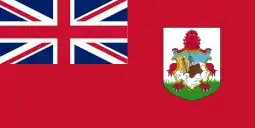
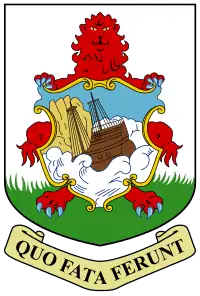


Countries.png.webp)